Different Styles of Fashion Timeline for Women
Chaloner Wood // Getty Images
Women'due south way trends from the past 100 years
Fashion is then much more than than a "beautiful outfit"—it's a major reflection of the times and a big role of American history. Since the inception of the fashion industry, womenswear trends have always been driven past culture, events, popular music, and celebrity influence. In the last 100 years alone, there have been some big changes in women's fashion.
At the beginning of the 20th century, styles were proper and demure, with high-necked dresses and hemlines that brushed the floor serving as the wait of choice. By 1920, though, women began to feel empowered and experiment with short flapper dresses and modern, boyish haircuts. Over the next century, fashion connected to evolve: War-rationed fabrics and gloves disappeared once women joined the workforce—starting time in boiler suits, then somewhen in power suits. The disco era brought sensual silhouettes and vibrant colors and paved the fashion for pop princesses like Britney Spears, who fabricated the crop peak a function of everyday street style.
From vesture to accessories, undergarments to shoes and even haircuts, cultural shifts, and societal movements over the past century have brought American women on a wild manner ride. Some looks, like the feminine A-line silhouette and cool leather jacket, are quite perennial; other unique fads (JNCO jeans and matching velour tracksuits, anyone?) have stayed in the past. At that place are even some trends, similar capri pants and pleated skirts, that had a moment early on and came dorsum over again decades later on. Currently, chunky dad sneakers are a thing, although the shelf life of this fad is nevertheless to exist adamant.
In commemoration of American mode, Stacker compiled a list of 50 women'south fashion trends from the past 100 years that left their marks on history. Nosotros've gathered our looks and data from other reputable way-oriented sources and blogs.
You may also like:Men'south manner trends from the past 100 years
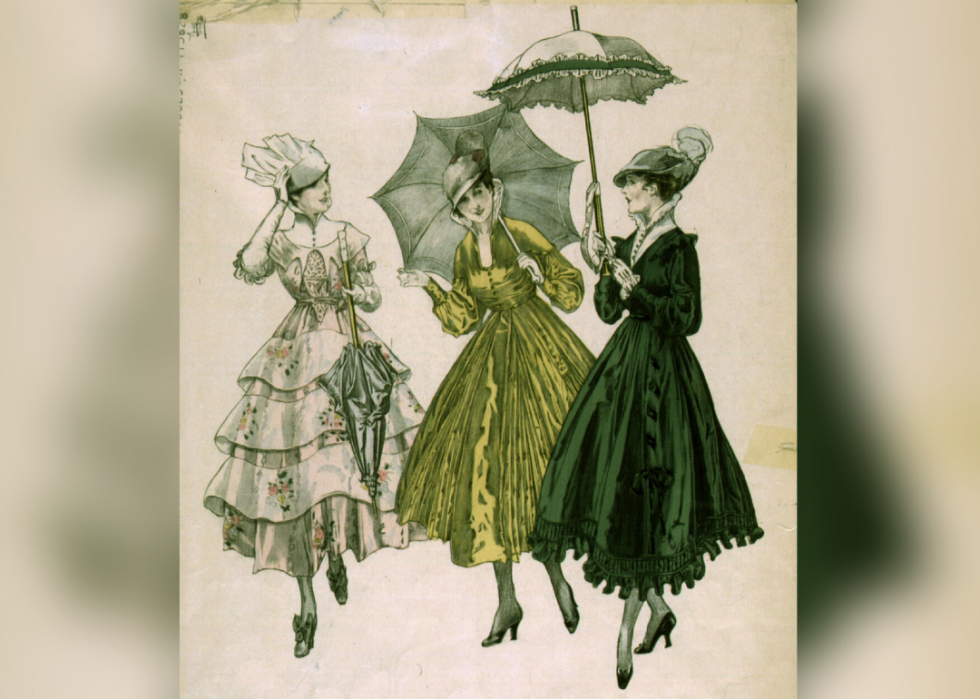
1 / 50
Hulton Archive // Getty Images
Edwardian dresses
At the beginning of the century, women'south mode was very romantic and feminine, and, almost importantly, modest. Remember garden party-chic gowns designed with puffy sleeves and ladylike silhouettes, in fabrics such as cotton, chiffon, and lace. Hemlines covered the talocrural joint and potent, high-boned collars the neck. A parasol accessory completed the look.
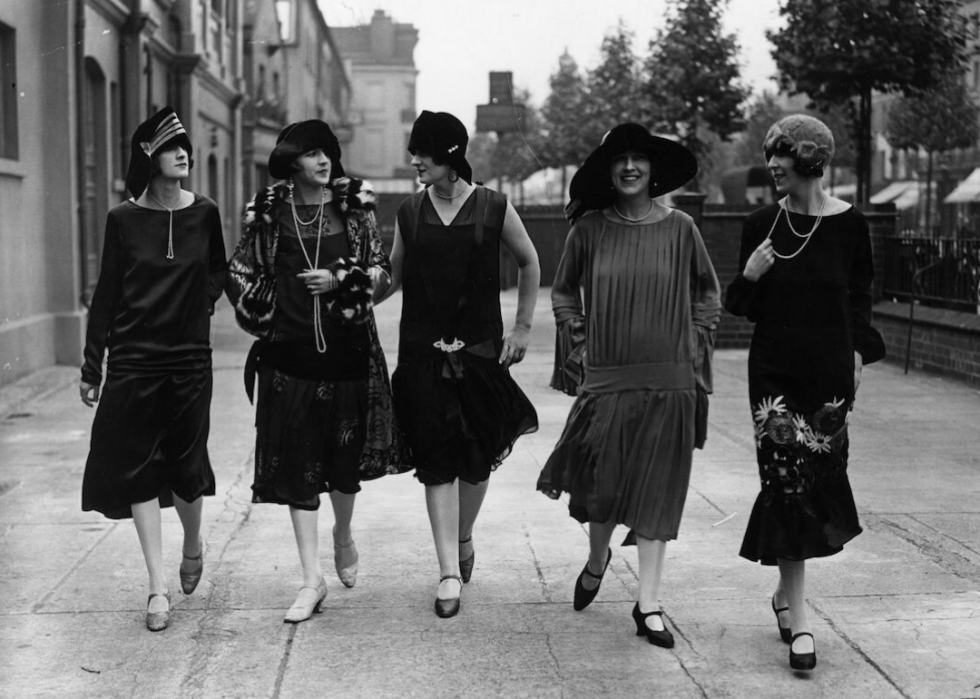
two / 50
Topical Press Bureau // Getty Images
Flapper dresses
Later World War I, female fashion swung in the opposite direction. Women felt empowered equally they gained the right to vote. Additionally, jazz music and prohibition were cultural milestones in the 1920s. During this shift, women broke out of the mold in a sartorial fashion with the flapper dress—a driblet-waisted shift wearing apparel with decadently beaded fringe. Hemlines rose to the ankle and and so above it, and women sported sleek short hairstyles.
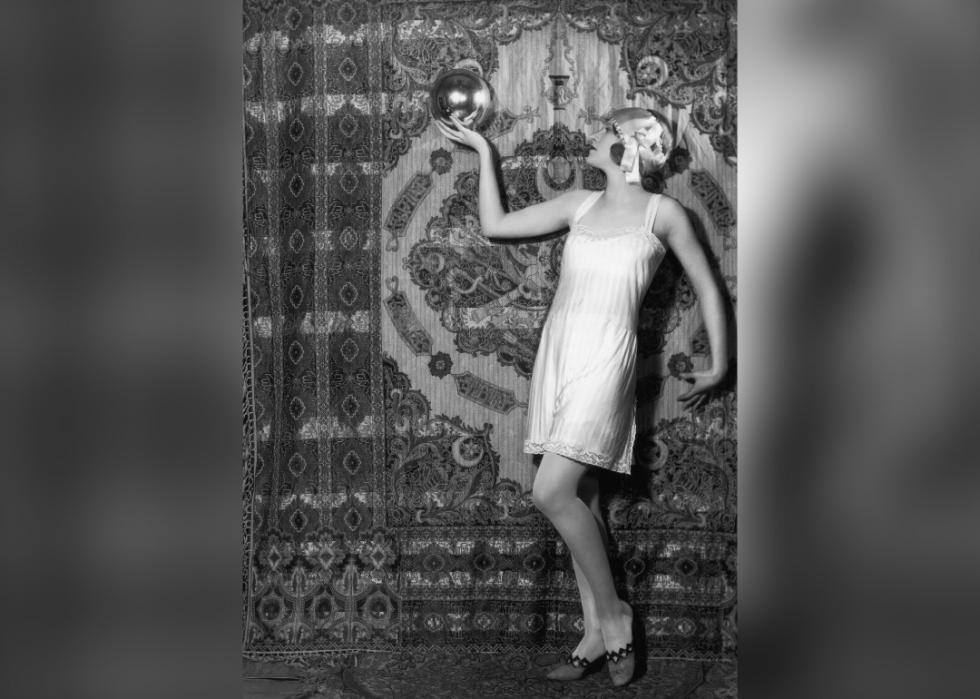
3 / l
One-slice lingerie
By the aforementioned progressive token, the '20s marked the decade when women began freeing themselves of restrictive corsets. With the newly historic boyish effigy (and flatter chest) en faddy, one-piece lingerie like silky chemises, sparse camisoles, and panties became the undergarments of pick, since they fit very comfortably under flapper dresses.
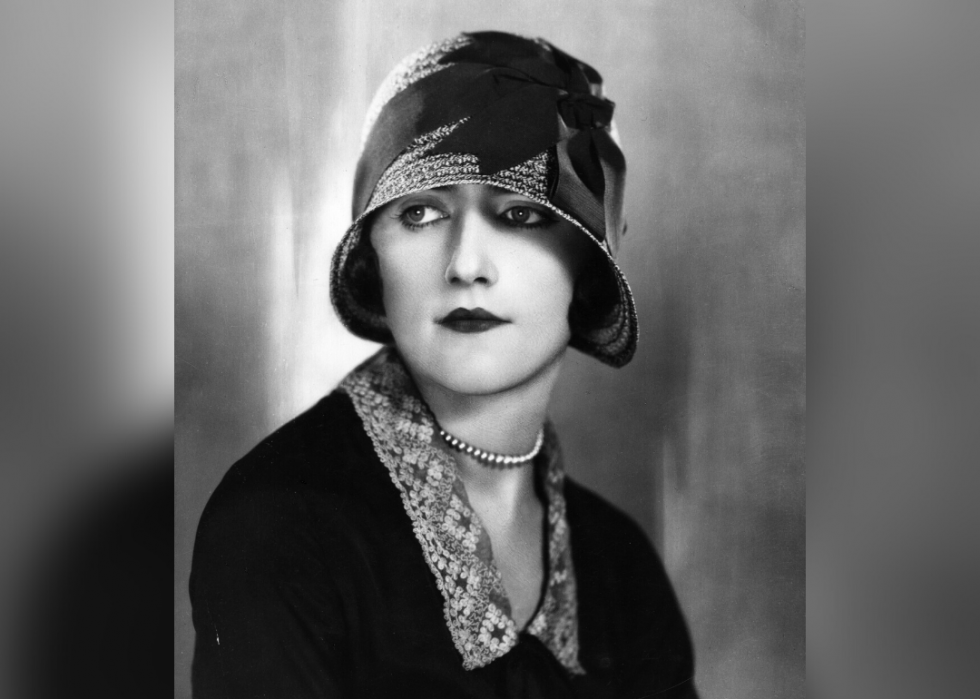
4 / 50
Cloche hats
Fashion over part: The cloche hat was a wardrobe staple throughout the 1920s. It featured a distinctive round meridian and a low brim that made information technology hard for most women to see without tilting their heads back. That said, the hat's accentuating decorative flower or bow made up for it by providing feminine flair.
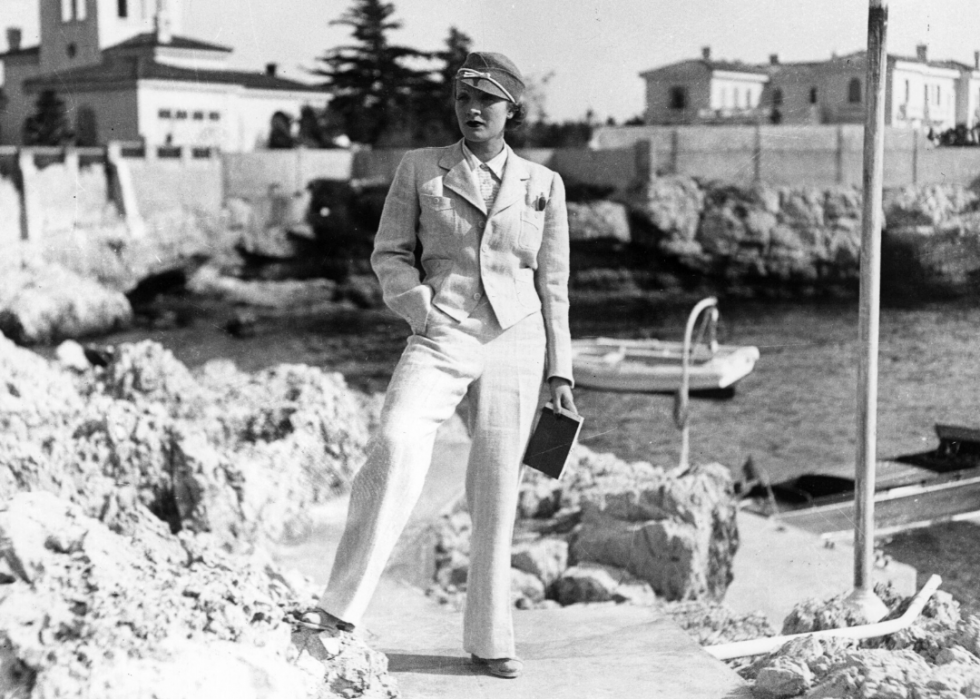
5 / l
Central Press // Getty Images
Indomitable pantsuit
Although female pantsuits were nonetheless uncommon in the '30s, a few daring women embraced the look of pants in a brash endeavor at abolishing gender roles. Italian designer Elsa Schiaparelli oft dressed actresses similar Marlene Dietrich and Katharine Hepburn in chichi pantsuits. Dietrich even wore pants onscreen in the Oscar-winning film "Kingdom of morocco," proving a woman can indeed vesture the pants if she wants to.
[Pictured: Marlene Dietrich wearing a signature look in 1932.]
You lot may also like: 10 toxic cleaning products and their natural alternatives
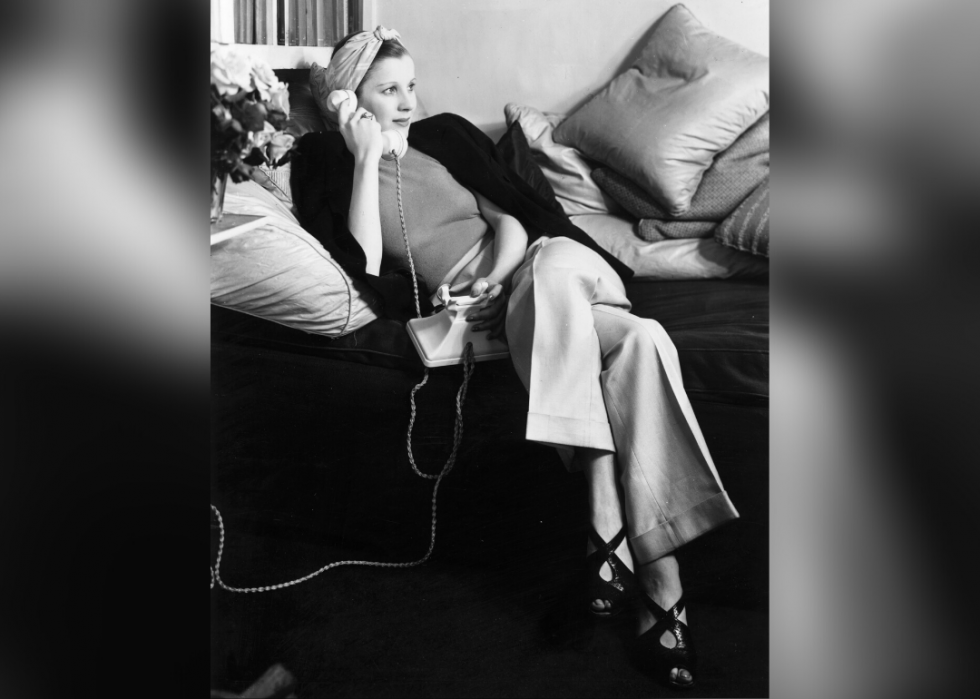
6 / 50
Broad-leg pants and trousers
Although the U.Southward. was plagued past the Great Low during the 1930s, it was still a noteworthy time for fashion. Continuing the trouser trends that appeared before in the decade, Extra Katharine Hepburn showed women everywhere how to borrow style from the boys, pairing wide-leg trousers with a chichi blazer and oxfords.
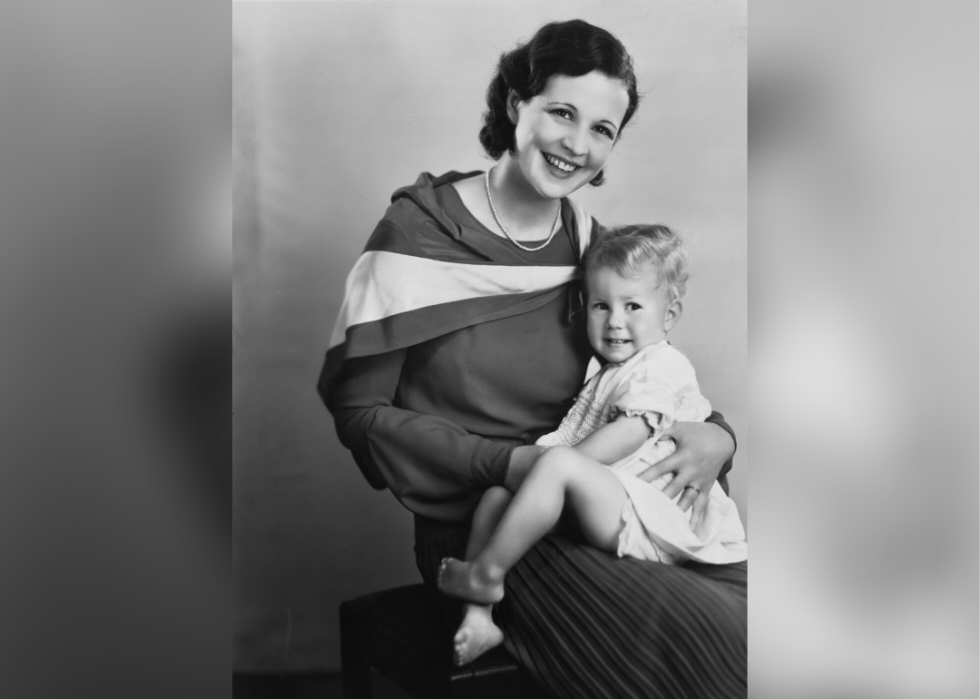
7 / l
Draped scarves
While smaller scarves tamed hair and larger ones added warmth effectually the chest, draped scarves, attached with scarf buckles and clips or tied in a knot, complimented clothes past adding a pop of colour to otherwise bland outfits. Spacial and patterned designs, particularly polka dots, were popular during the '30s. Later, the 1940s saw visual artists like married couple Zika and Lida Ascher turning out patterned scarves, which they used as a medium for their work.
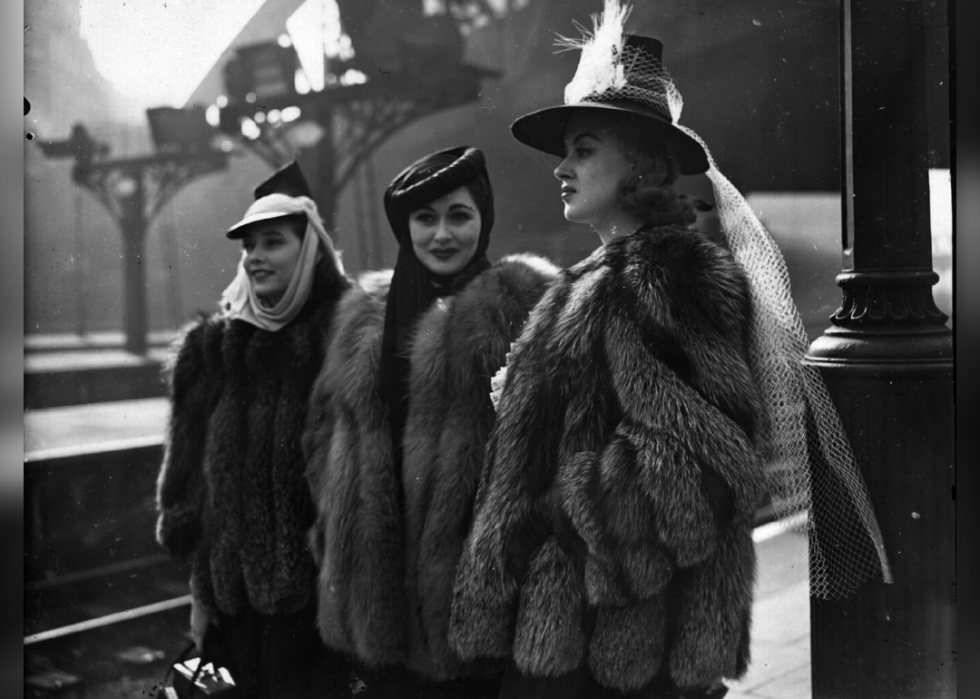
viii / 50
David Savill/Topical Press Bureau // Getty Images
Fur accessories
Suitable for both daytime and evening diplomacy, fashionable fur was a status garment to own and habiliment in the 1930s. In the 19th century, fur was a necessity for men and women who lived in colder climates. By the mid-20th century, information technology was almost exclusively worn by women. Once fur coats and stoles were seen as high fashion items of luxury, the cost of fur began to ascent.

ix / 50
Brooke/Topical Press Agency // Getty Images
Mary Jane shoes
A staple in every little girl's wardrobe, Mary Jane shoes were born in 1902, modeled later a Buster Brown comic volume character of the same name. Since then, the apartment shoe with a small leather strip has been shaped into heels, paired with piffling white socks, and bedazzled in sequins. Mary Janes were a favorite of '60s supermodel model Twiggy and are oft worn by contemporary fashionistas, proving that Mary Janes are one style that has stood the exam of time.
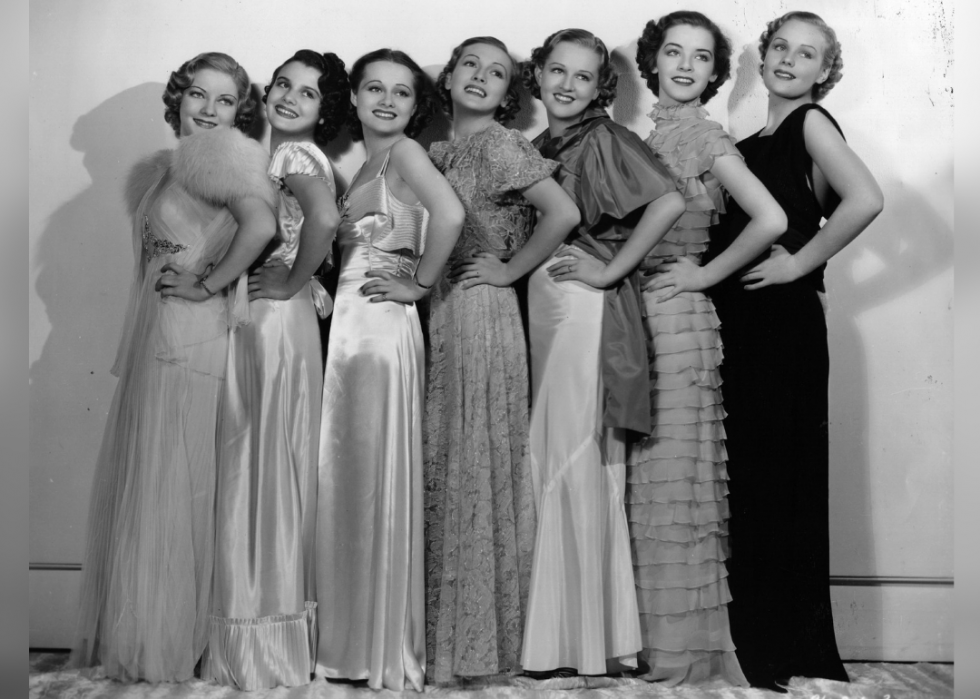
x / 50
Hulton Archive // Getty Images
Evening gown
Class-fitting, flooring-length dresses inspired by Hollywood glamour gave everyday women in the '30s a taste of elegance. Speaking of Tinsel Town, red carpet events, including the Academy Awards, inspired some of the almost notable evening gown silhouettes of all fourth dimension, many of which are still popular today. The biggest divergence between the original dresses and today's versions is that yous can at present rent gowns through companies like Hire the Rail, giving any woman the opportunity to wait like a star.
You may as well like: History of dogs in space
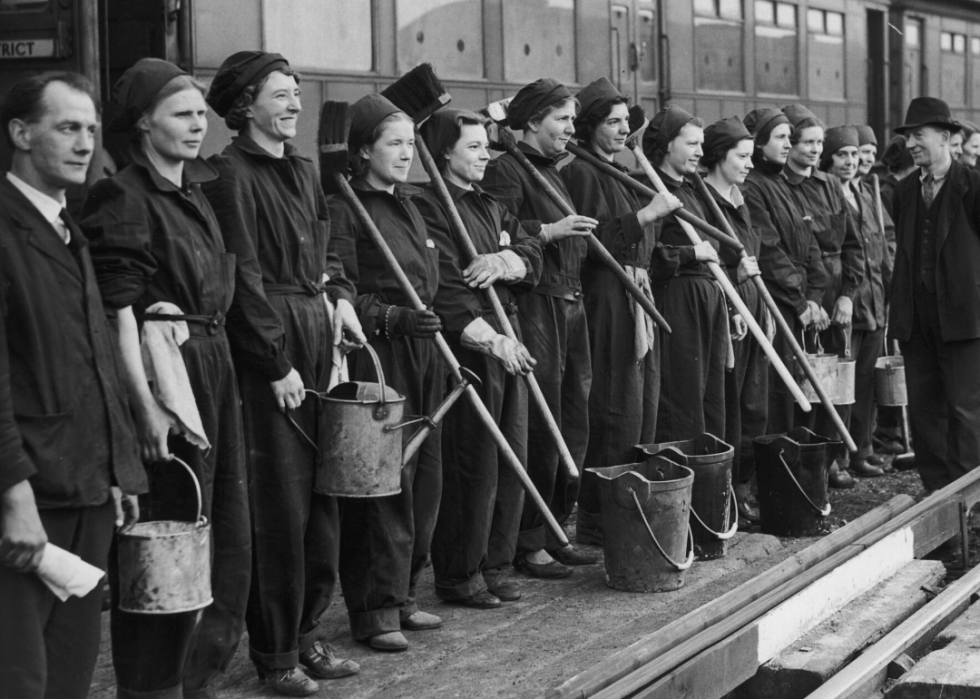
11 / 50
Reg Speller/Fob Photos/Hulton Archive // Getty Images
Banality suits
The U.Southward. officially entered WWII in 1941. With thousands of men drafted into the war, women began entering the workforce—often taking on industrial factory jobs that were previously held by men. These physically enervating jobs called for women to vesture loose-plumbing fixtures banality suits made of denim or heavy canvas that buttoned down the front. Rosie the Riveter posing in a denim boiler suit quickly became an iconic epitome of the time.
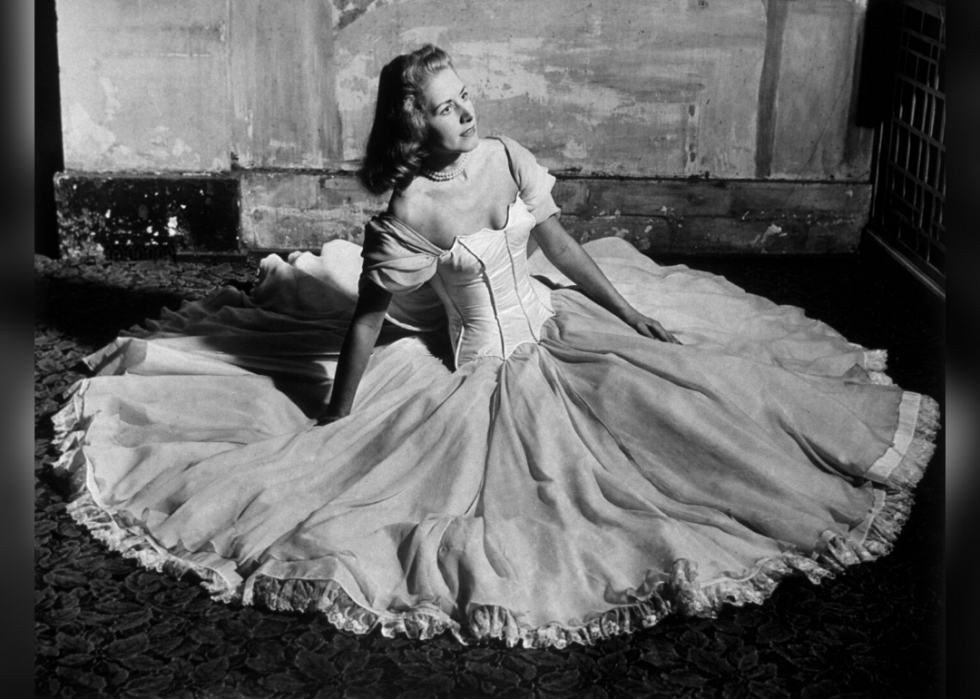
12 / 50
Flim-flam Photos // Getty Images
Ruffled everything
The pop ruffles and frills fad took inspiration from 15th-century military machine regalia, which featured ruffled collars and sleeves. Past the stop of the 19th century, this romanticized feature was strictly for females. The 1950s saw an end to wartime fabric rationing, and designers celebrated by adding voluminous layers to both daily and evening wear designs. Past the finish of the 20th century, the ruffled blouse fabricated boob tube history when a "Seinfeld" episode centered around one particularly puffy shirt.
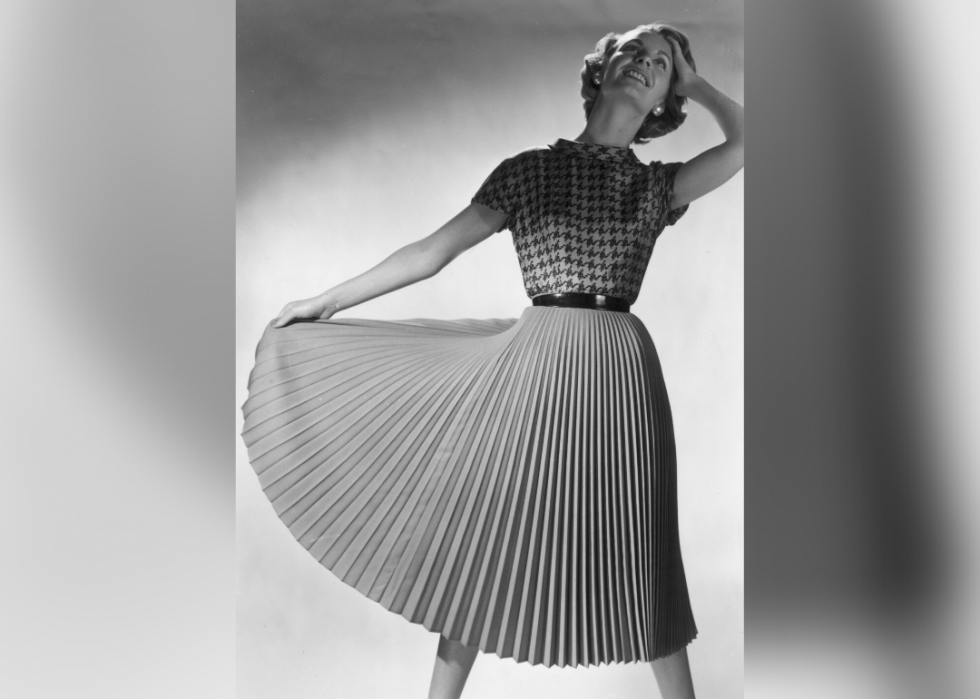
xiii / 50
Chaloner Woods // Getty Images
Pleated human knee-length skirts
Circa 1944, whatsoever rationing restrictions that were put on fabrics during the state of war were finally lifted; with that, playful design elements similar pleats came back onto fashion, giving women a petty more pep in their footstep. All-around pleats and pocketknife pleats were common in skirts, as were brilliant colors, which signaled a cultural commemoration of the war's end.
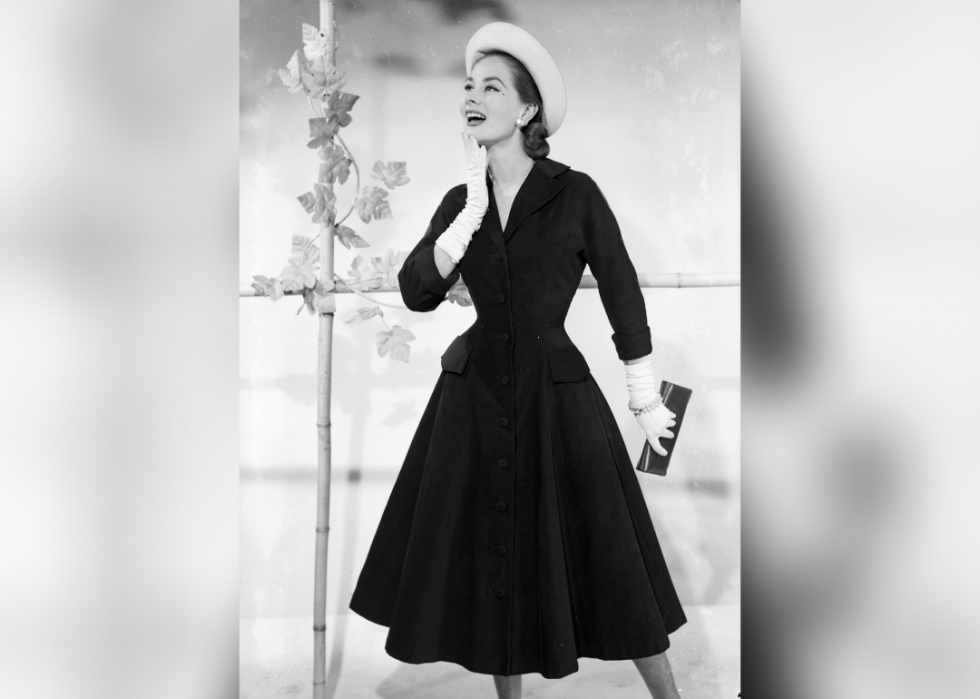
14 / 50
Chaloner Wood // Getty Images
A-line silhouette
In 1947, style mogul Christian Dior debuted his "New Look" that would chop-chop take the globe by storm. The feminine A-line silhouette boasted a full, flowy skirt and an accentuated waistline that was designed to highlight a woman'south hourglass figure—a singled-out dissimilarity to the masculine looks from pre-WWII.
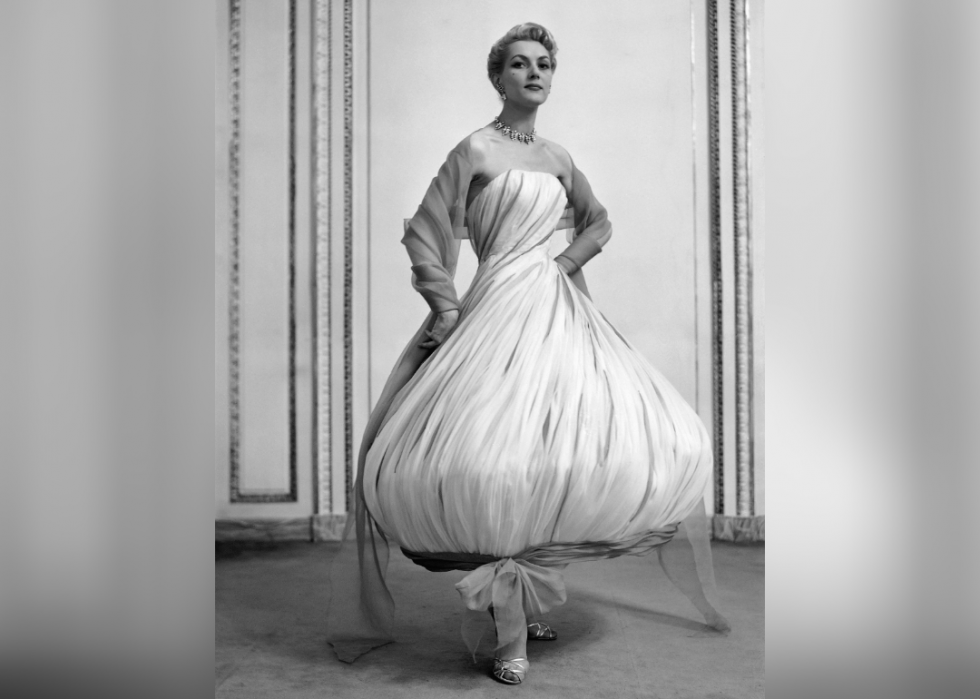
xv / l
The bubble hem
Called a distant relative of the harem pants, the bubble hem was born in 1949 and created a whole new type of tailoring. Past the '50s, the bubble hem turned into the bubble wearing apparel and bubble skirt, which tapered in at the waist and flared at the bottom. The look, popularized by designers Pierre Cardin and Hubert de Givenchy in the mid-19th century, hit the runways again in 2019, specifically seen in the 2020 Louis Vuitton'due south Prowl 2020 drove.
You lot may also like: Where U.S. kickoff ladies went to college
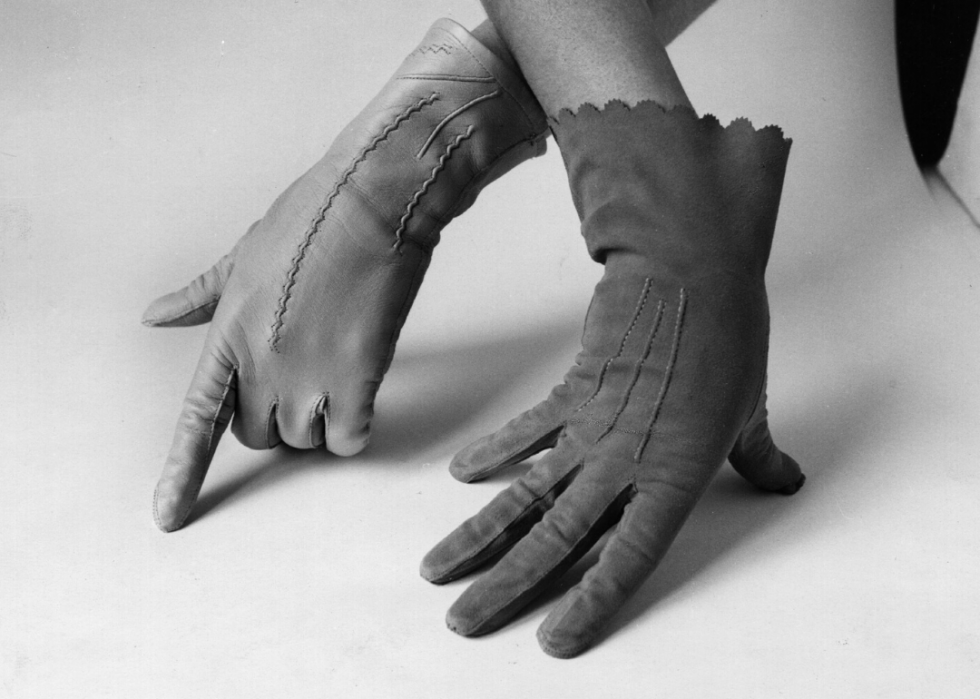
16 / 50
Philip Turner/Hulton Archive // Getty Images
Leather and suede gloves
Gloves were some other item of clothing that had been rationed during the war. Come 1950, gloves experienced a renaissance as a popular and ultra-femme accessory (with, of course, a matching bag and hat). For daytime appearances, many women stepped out wearing wrist-length gloves in neutral hues.
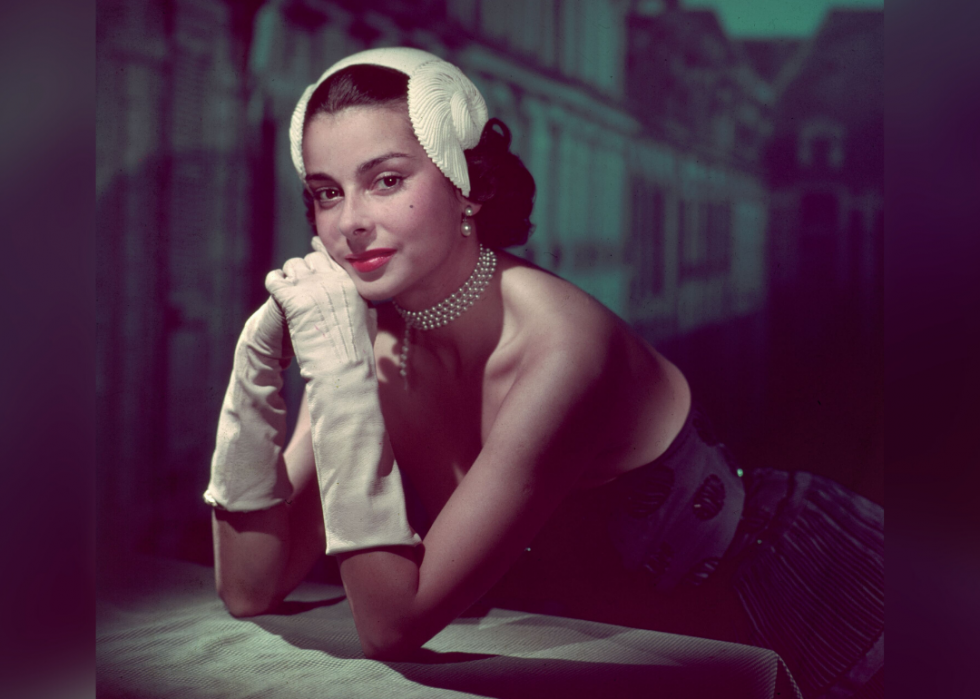
17 / 50
Pearl jewelry
In the 1950s, the easy elegance of pearl jewelry became synonymous with post-state of war domesticity. With the men back from war, women were expected to get dorsum to keeping house and looking well-kempt while doing so. Pearl stud earrings and necklace strands added a touch of chicness to any outfit—from afternoon frocks to little black dresses. Grace Kelly, a large pearl-wearer, made the await iconic.
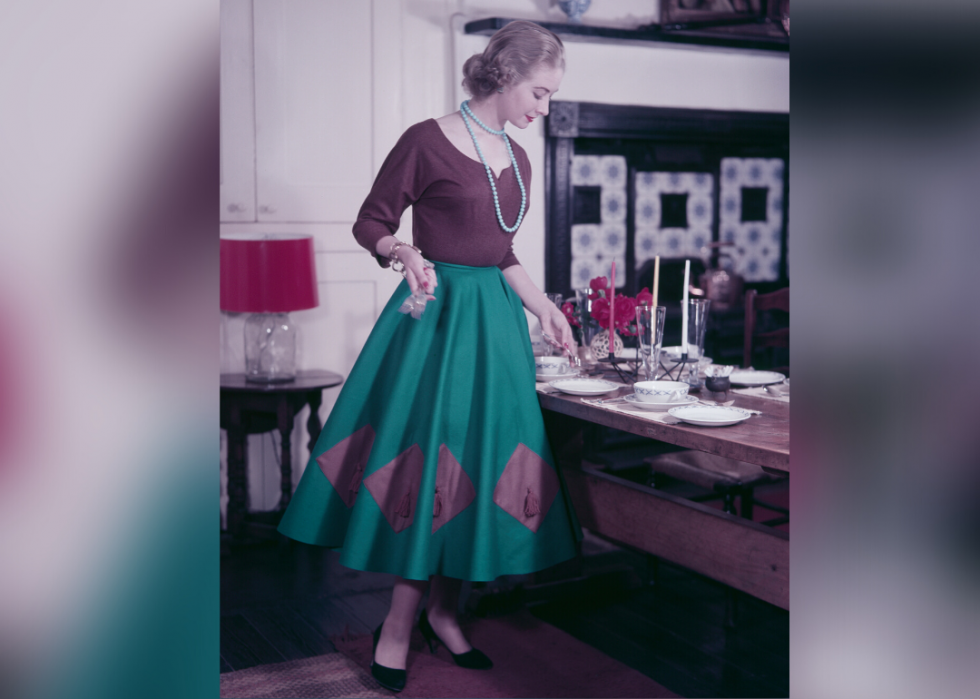
18 / 50
Hulton Archive // Getty Images
Swing skirts
Is whatever item of clothing more quintessentially 1950s than a poodle skirt? Circle skirts could make a statement past mode of bright colors, polka dots, and other novelty prints. To consummate the look, all you needed was a cropped cardigan, Buddy Holly playing on the jukebox, and a chocolate malt in manus.
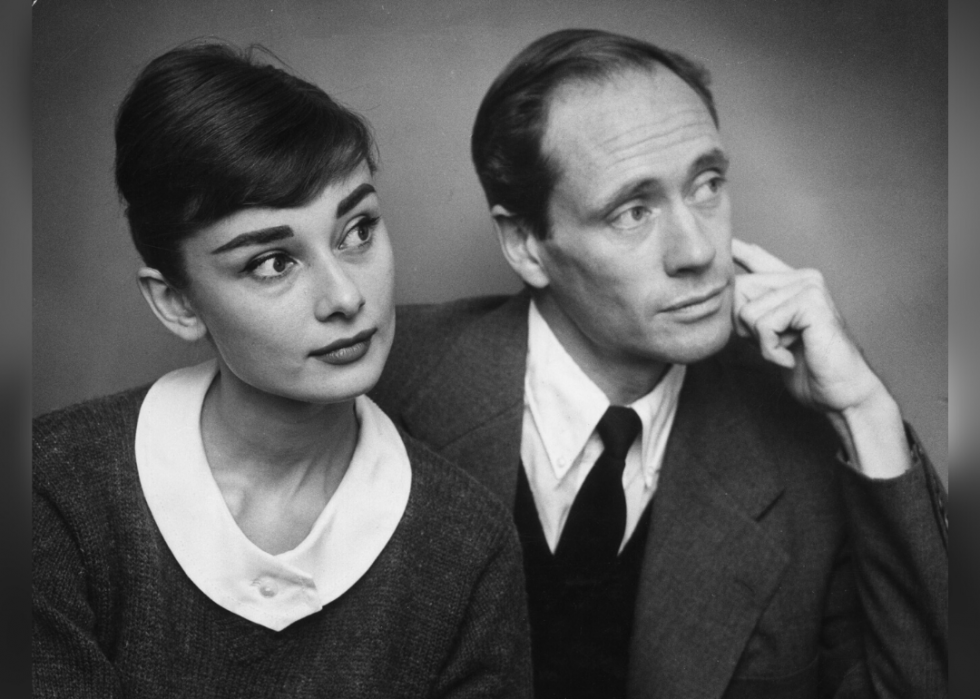
19 / 50
Peter Pan collars
This popular await from the 1950s garnered its name from the costume designs of the original "Peter and Wendy" theatre production in New York City. The fashionable neckband features rounded corners and is designed to lay flat against the neckline; it was added to many types of garments over the years, including large, swinging dresses.
[Pictured: Audrey Hepburn beside her husband Mel Ferrer.]
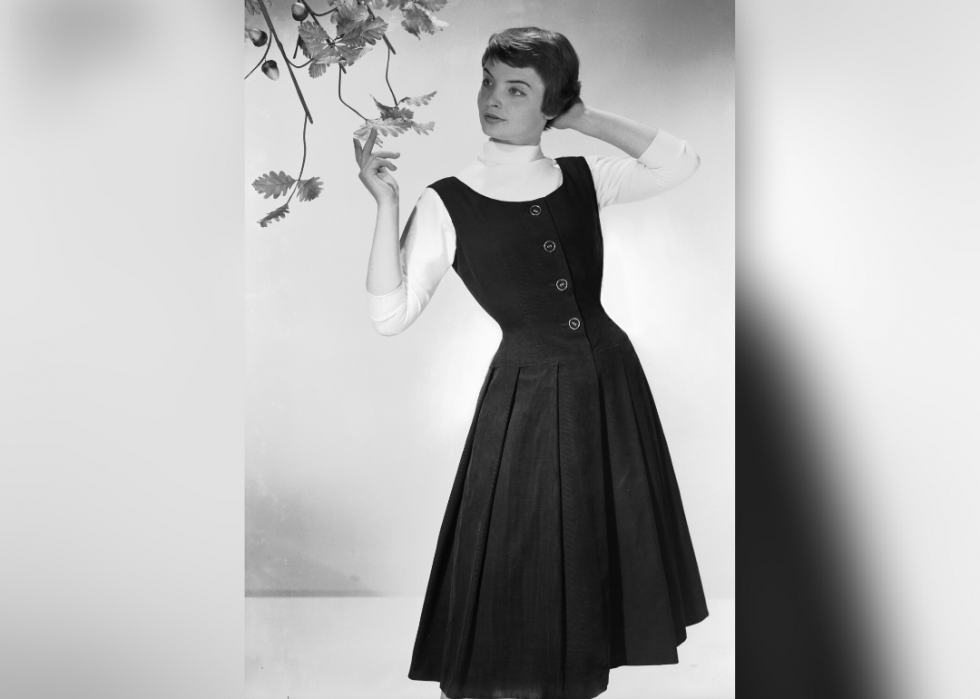
xx / 50
Chaloner Woods // Getty Images
Schoolgirl-inspired clothes
Fashion historian Rebecca Tuite has detailed how the uniformed look of schoolgirl-inspired clothes began in the '50s with Peter Pan-collared blouses and curt, pleated-plaid skirts. While popular-star Britney Spears may exist the most pop glory clad in schoolgirl-inspired clothes, other current-day starlets famous for sporting the look include Megan Fox and Kate Upton.
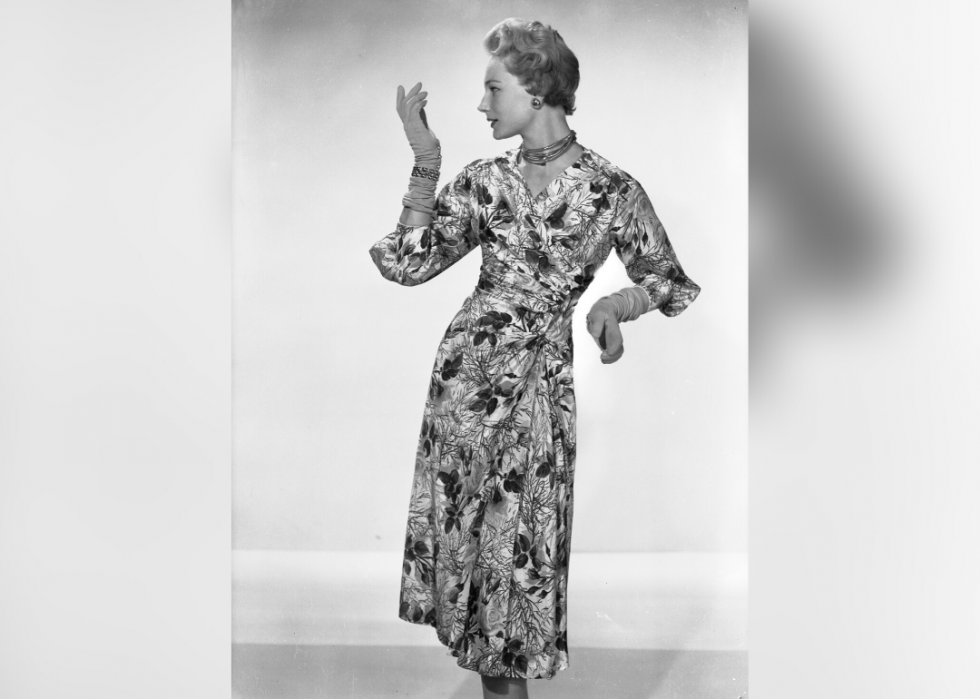
21 / 50
Chaloner Woods // Getty Images
Printed wrap apparel
Unlike the swing, coat, or shirt dresses of the '50s, the mid-century printed wrap was more modern, made of colorful patterns that swathed the body. Polka dots, florals, checks, and stripes, and even more far-out themes similar science and western patterns, were popular at the time. The populary of the wrap dress endures today, thanks to the style's flattering sihoullette on women of all shapes and sizes.
You may also similar: 25 pictures of abandoned military installations and their stories
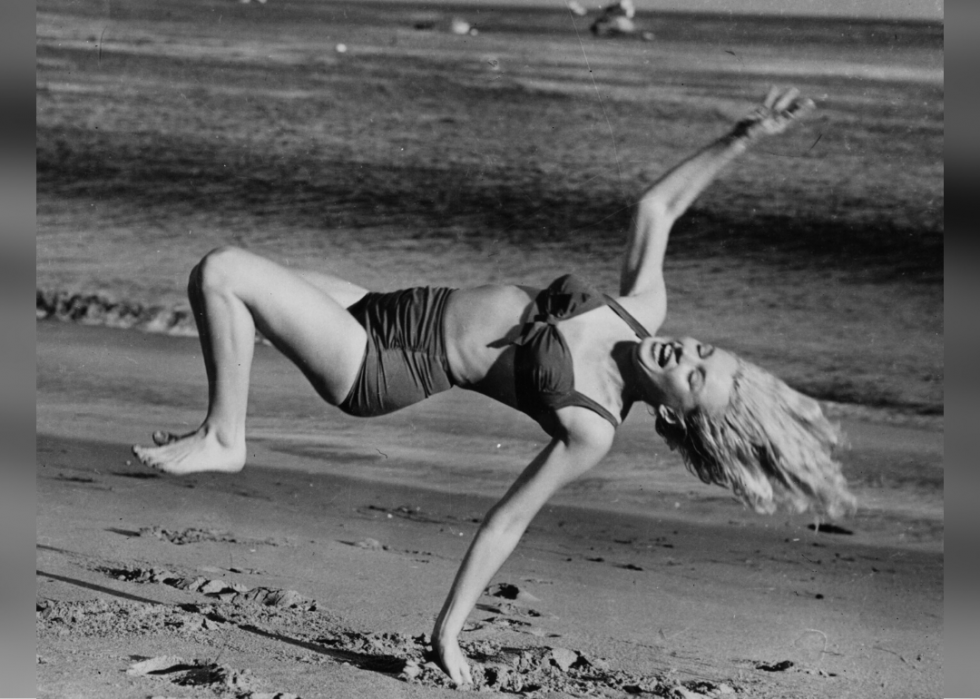
22 / 50
L J Willinger // Getty Images
The bikini
Pinup daughter Jayne Mansfield dared to bare in bikinis—and many regular women followed arrange, but in a slightly more modest fashion. Two-slice bathing suits made a sexy splash in the '50s with loftier-waisted bottoms, skirts, and playful patterns.
[Pictured: Marilyn Monroe photographed on the California coast in 1950.]
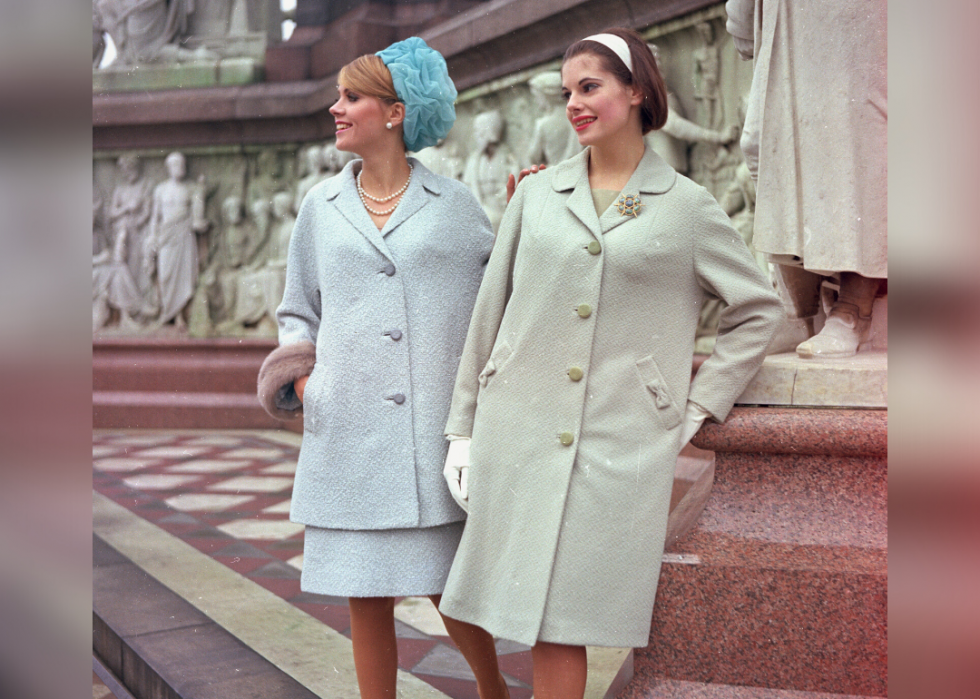
23 / 50
Chaloner Woods // Getty Images
Pillbox hat
In the early 1960s, First Lady Jacqueline Kennedy became a top manner idol for women. She was the image of sophisticated elegance with outfits that always looked flawless from head-to-toe—this included her signature pillbox hat, which speedily made its way into many women'southward everyday looks.
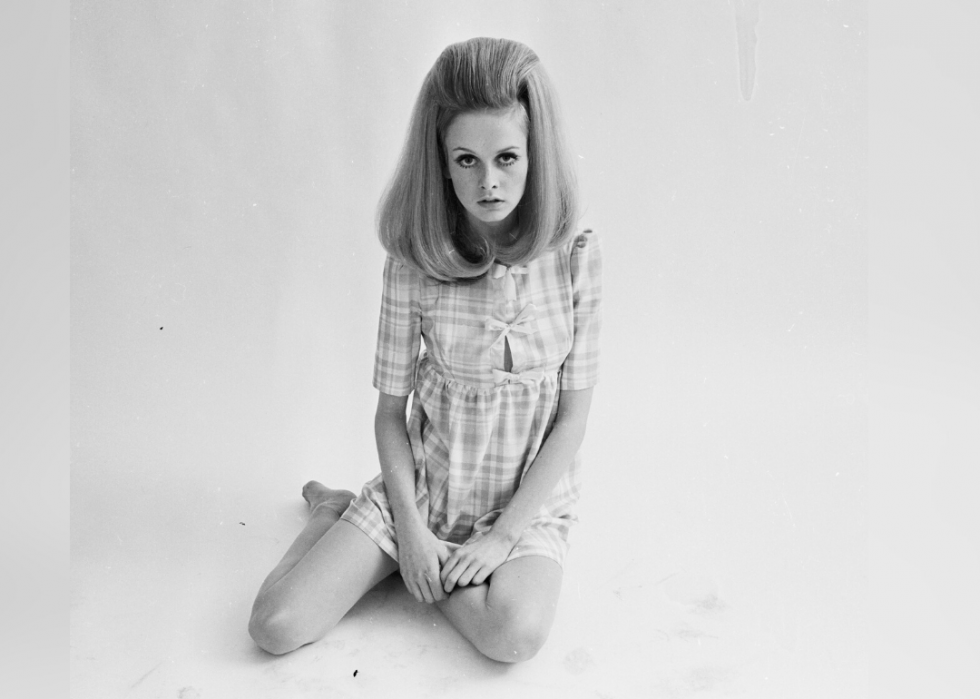
24 / 50
McKeown/Express // Getty Images
Babydoll dresses
The second moving ridge of feminism during the 1960s empowered women to proceed expressing themselves, both ideologically and stylishly. Hemlines got shorter and colors got brighter with the babydoll wearing apparel—a become-to look of liberation for ladies. This bold, moderately shapeless silhouette was a favorite of supermodel Twiggy and was revived in the '90s by grunge rockers like Courtney Dear.
[Pictured: British fashion model and '60's icon, Twiggy (Lesley Hornby) wearing a checked infant doll way mini-dress in 1967.]
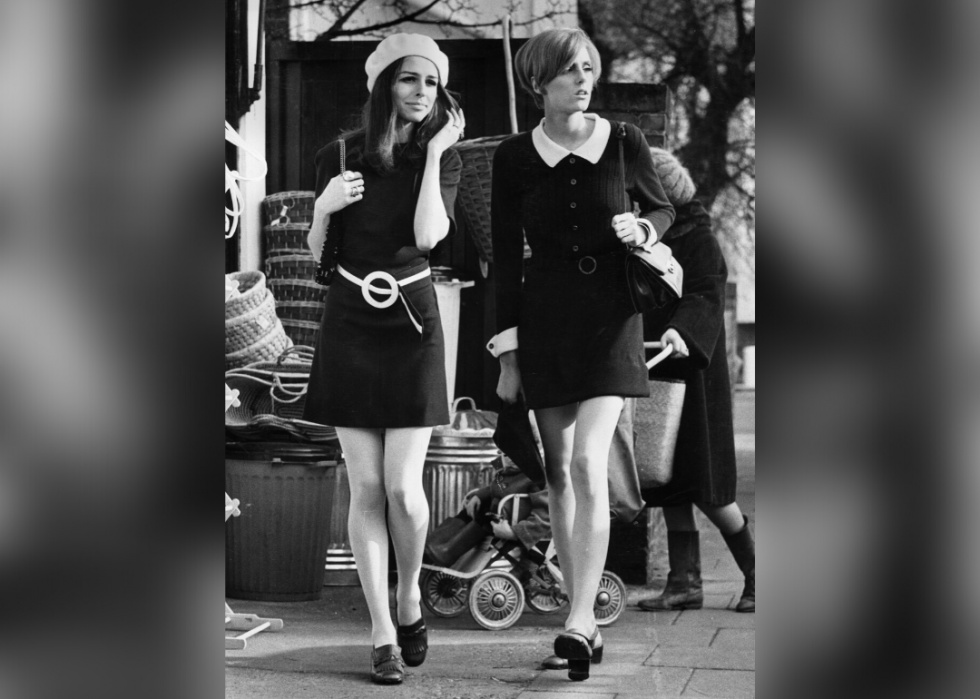
25 / 50
Roy Jones/Evening Standard // Getty Images
Mini skirts
The miniskirt was said to exist born in 1964 in designer Mary Quant's London boutique, Bazaar. Quant was inspired by street fashion, which led her to create a micro-skirt with a hemline that hit well above the genu. The style (and length) was considered daring at the time but took off nonetheless.
You may as well like: Could you laissez passer the U.S. citizenship test?
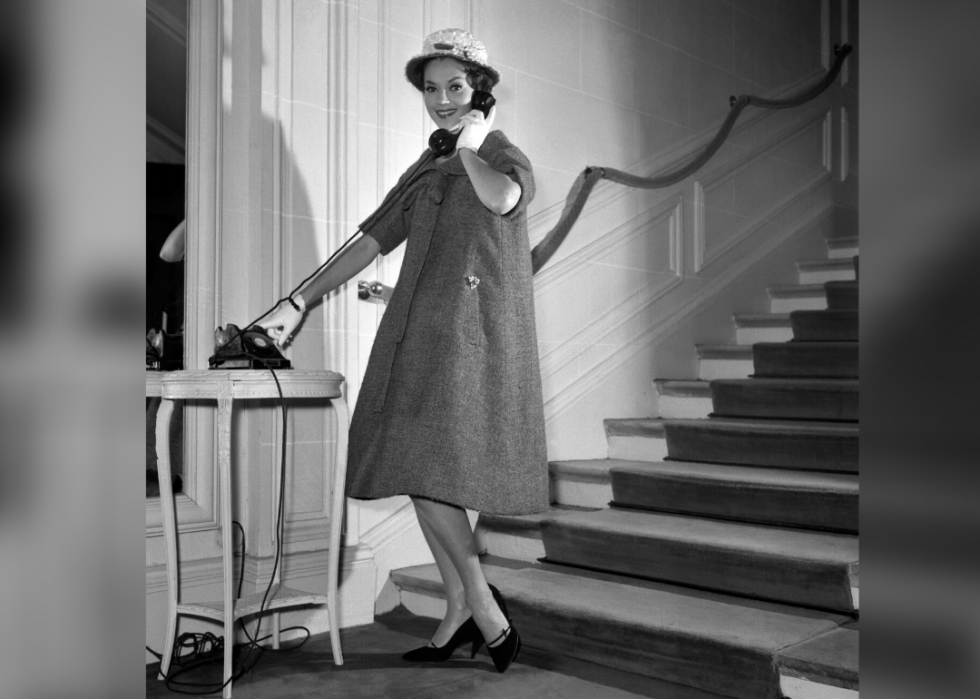
26 / 50
Trapeze silhouettes
The '60s waistless trapeze silhouette was oftentimes seen on Audrey Hepburn. The London-inspired style, which dates back to Louis XV, came to life when Yves Saint Laurent began designing dresses to flare out from a fitted shoulder line. Every bit the antonym to Christian Dior'south A-line, which cinched the waist and puffed at the bottom, Saint Laurent'due south silhouette still managed to give women a sexy entreatment.
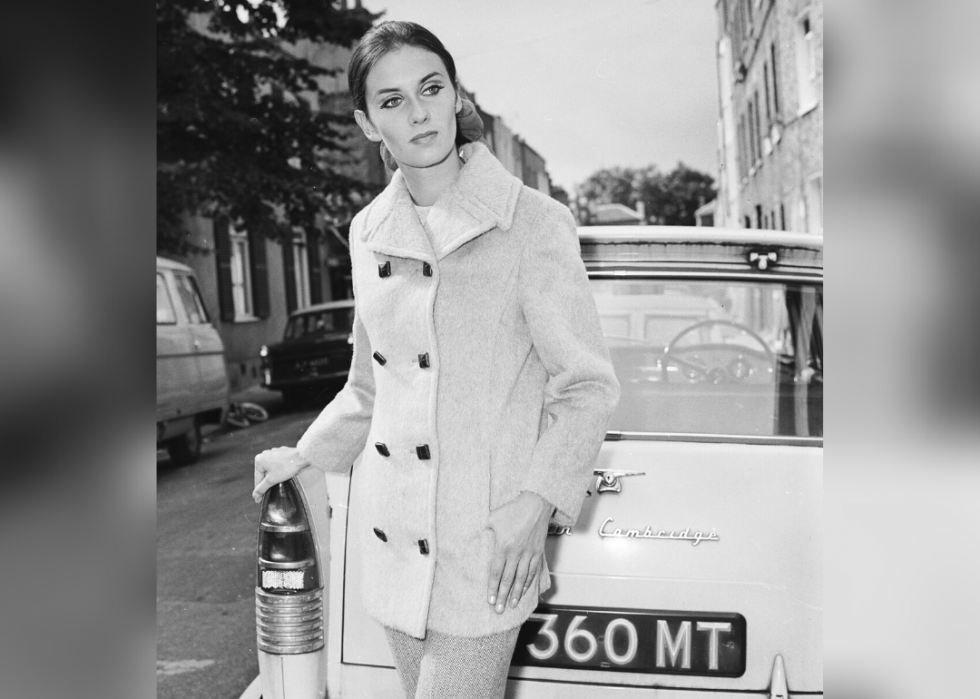
27 / 50
Chaloner Wood // Getty Images
Peacoats
By the '60s, sailors were non the only ones wearing peacoats, a short, double-breasted coat made of heavy wool. Rather than protecting sailors from a harsh ocean climate, beatniks began sporting the mode during the hippie historic period. The oversized neckband was ofttimes seen on actors Robert Redford and James Dean at the time.
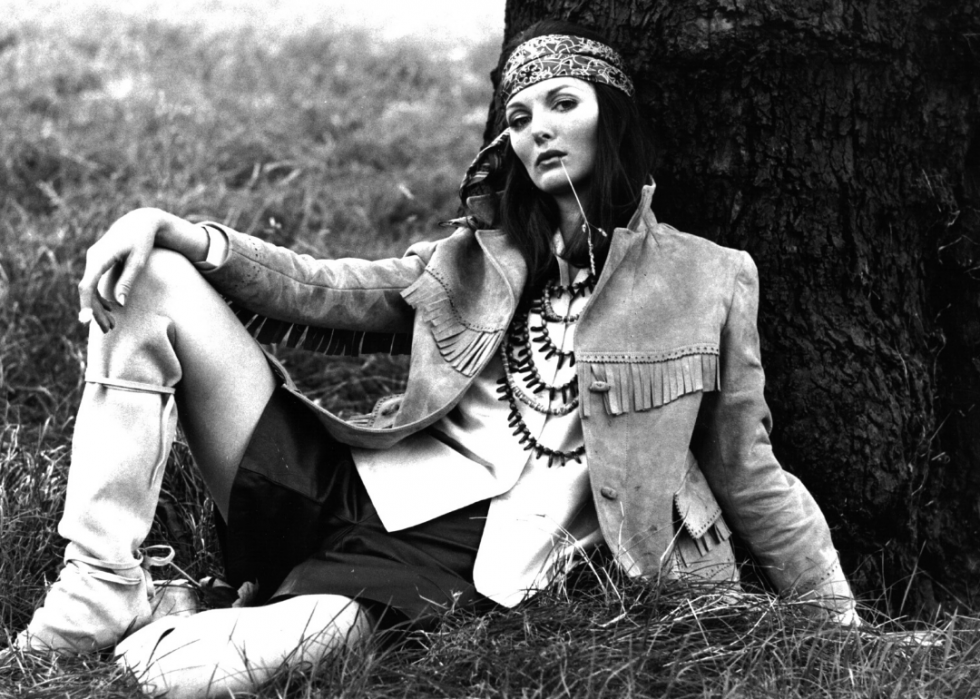
28 / 50
Evening Standard // Getty Images
Suede fringe vests
Hippie subculture made its marking during the tardily 1960s. This style exuded a very laid back bohemian vibe and pulled inspiration from cultures and countries all over the world, including India, Bali, Morocco, and Africa. Buck-skin vests with fringe were very pop pieces by the terminate of the decade.
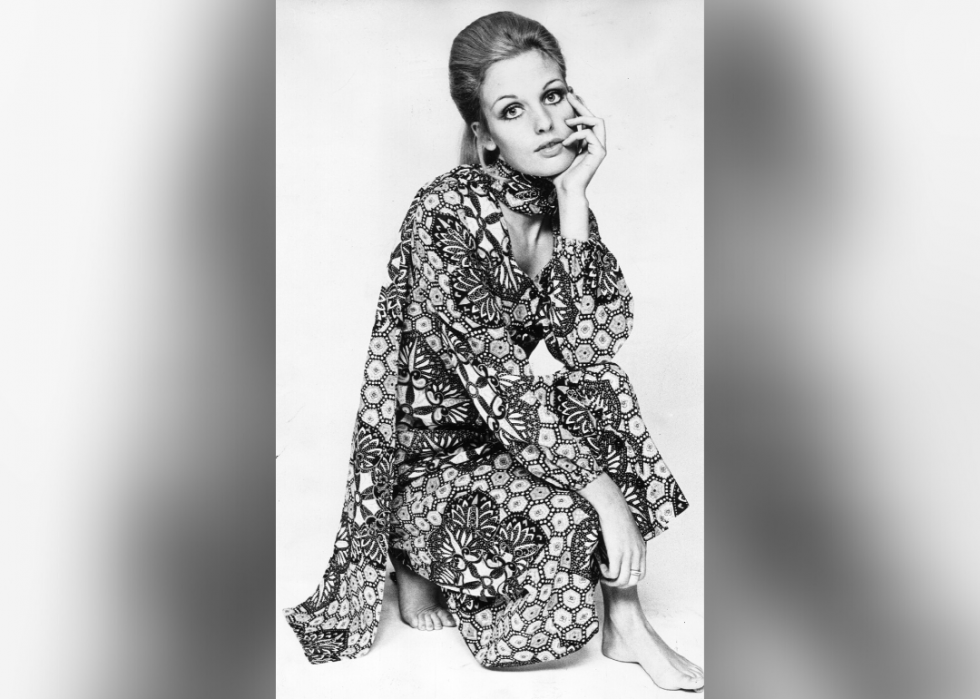
29 / fifty
Gordon Carter // Getty Images
1970s Psychedelic prints
Burgeoning between 1966 to 1972, psychedelic prints became the staple clothing design for the peace movement. The bold, flower-power colors mixed together were often worn by hippies to symbolically reverberate an open, LSD-fueled state-of-mind. Nowadays, Bohemian-style fashion is ofttimes found at musical festivals.
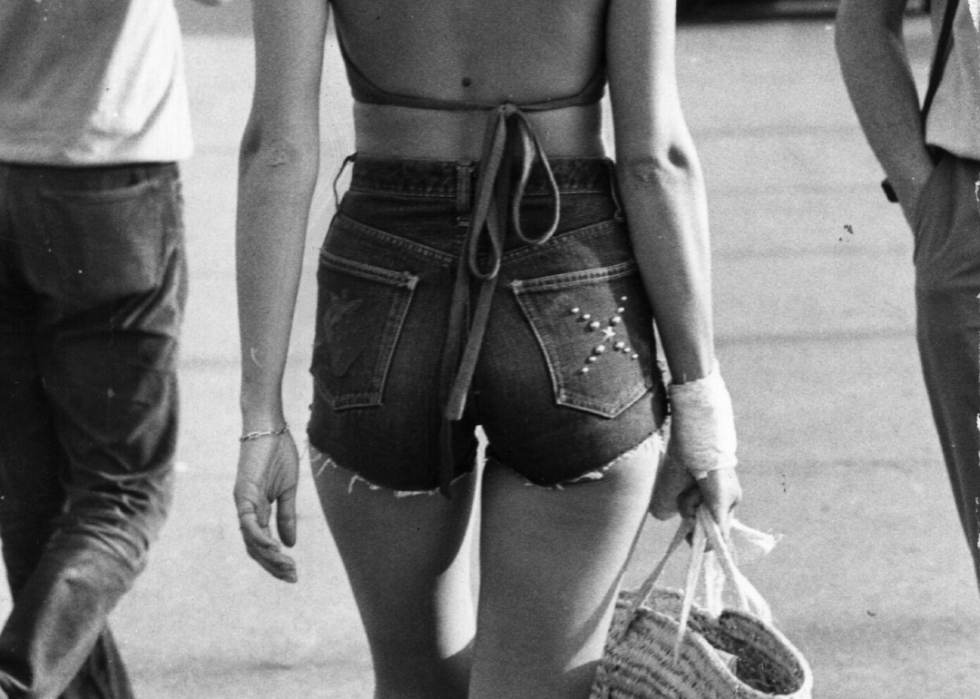
thirty / l
Roy Jones // Getty Images
1970s Daisy Dukes
The short, tight, denim cut-offs inspired by "The Dukes of Hazzard" television set graphic symbol of the same name, played by Catherine Bach, are still hot today. Since the Southern belle started the fashion craze, celebs similar extra Jessica Simpson—who played Daisy Duke in the 2005 moving-picture show remake—take kept it alive. The fashion statement even inspired the 1993 song "Dazzey Duks," a one-hit-wonder past rapper Duice.
You may besides similar: Do you know your country nicknames?
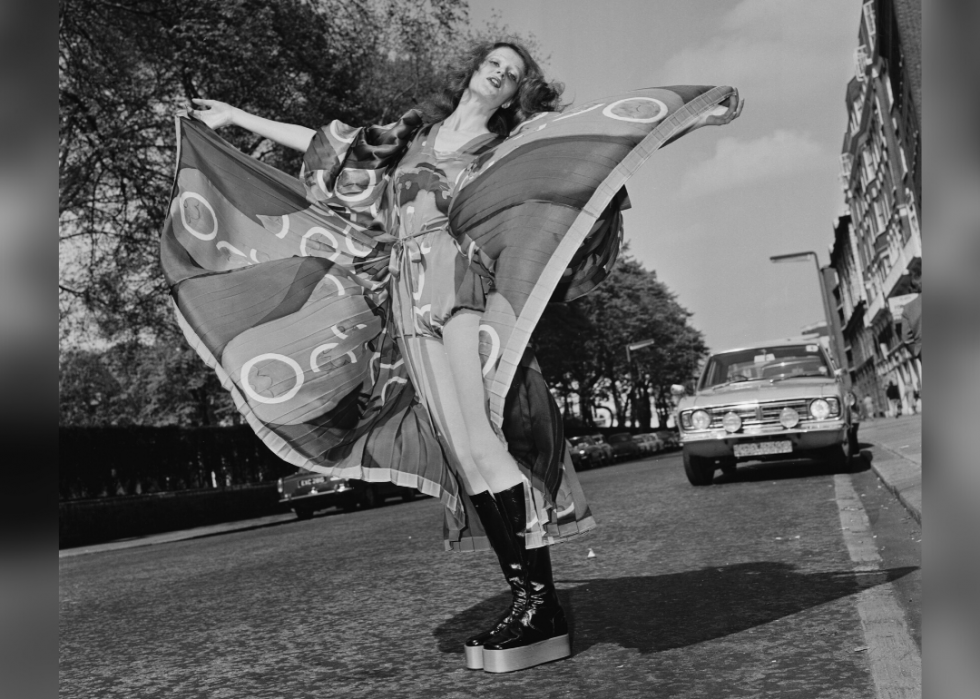
31 / 50
Blackman/Daily Express // Getty Images
Platform heels
Platform heels were synonymous with the decade of disco. Equally outfits got bolder, brighter, and more expressive in the 1970s, women's loftier heels and platforms rose to new heights. Wood, cork, and synthetic materials were common.
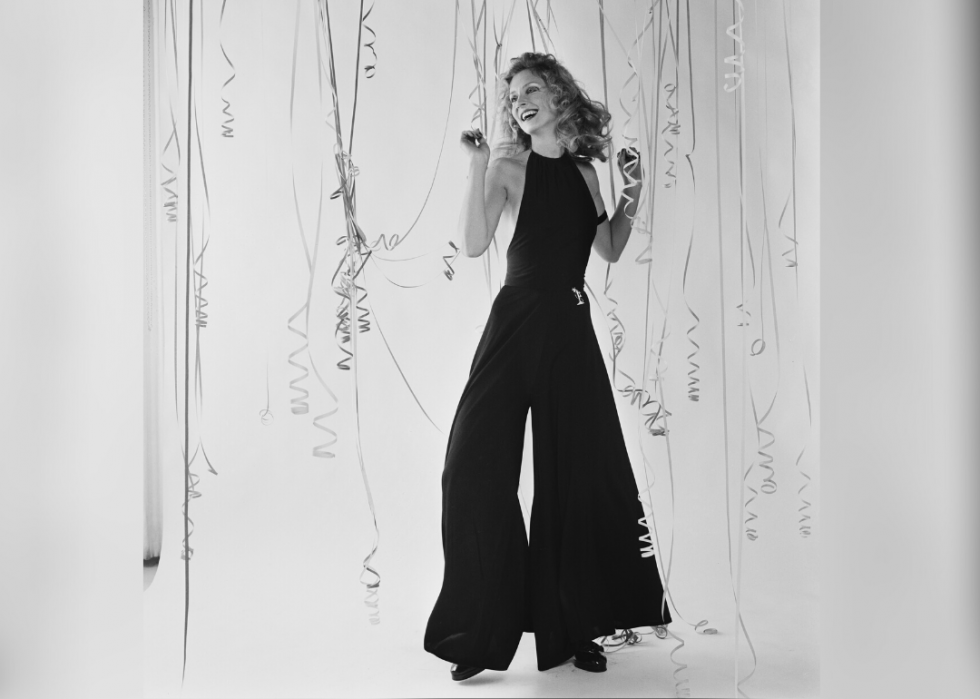
32 / 50
Mike McKeown/Daily Express // Getty Images
Bong bottoms
Flared pants—exist it casual denim or splashy patterns for the disco—were a big look in the late '60s and early on '70s. Interestingly plenty, bell bottoms were originally worn by sailors during the War of 1812, before they resurfaced during the '70s every bit a trend for women.
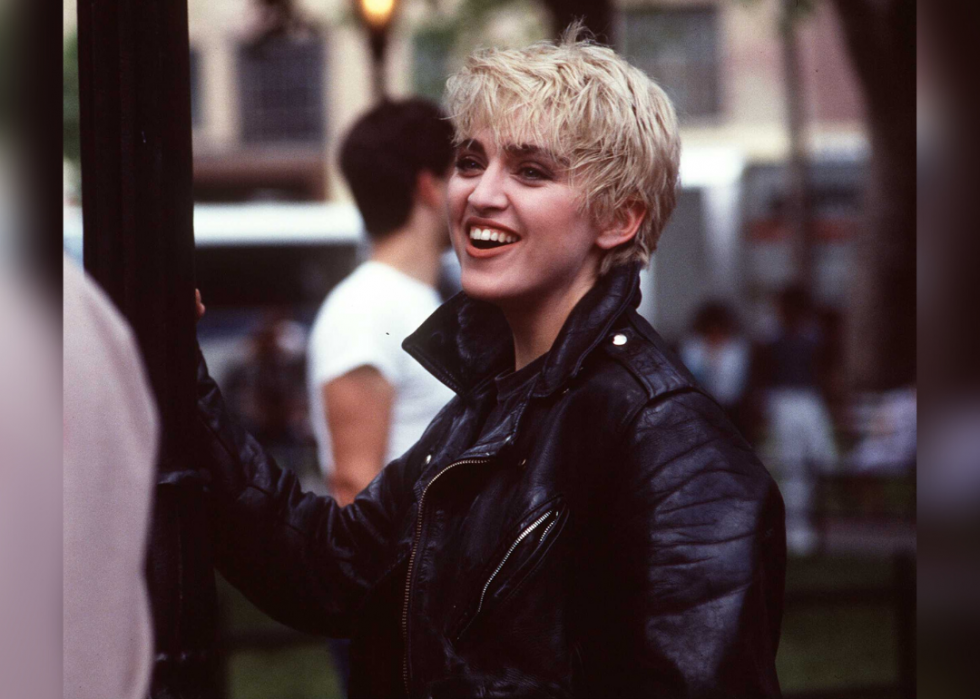
33 / 50
Brenda Chase/Online U.s.a. Inc./Stringer // Getty Images
Leather jackets
The vibrant colors and florals of disco began to fade away in the 1980s when metallic music came in with a bang. Fashion too swayed towards the opposite end of the spectrum, with black leather jackets and looser fits ascent in popularity—a la Madonna in her "Papa Don't Preach" music video.
[Pictured: Madonna wearing a leather jacket in 1986.]
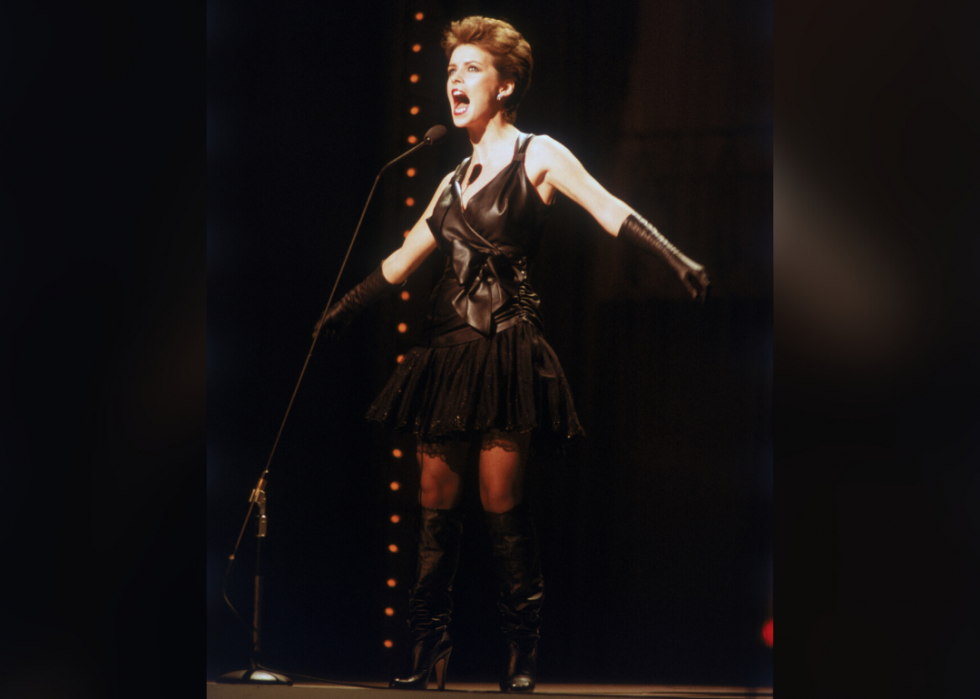
34 / l
Keystone/Hulton Archive // Getty Images
1980s pleather
Genuine faux leather, aka pleather, gained fame in the '80s when pop civilisation icons similar Michael Jackson and Eddie White potato wore the existent garb from head to toe. Unlike celebrities who could afford bodily animal peel clothing, fashionistas at the time settled for the fake stuff, mostly in the class of mini-skirts and shorts. The once-popular trend is new again, making a comeback on the 2019 catwalk.
[Pictured: Popular singer Sheena Easton performing in 1982.]
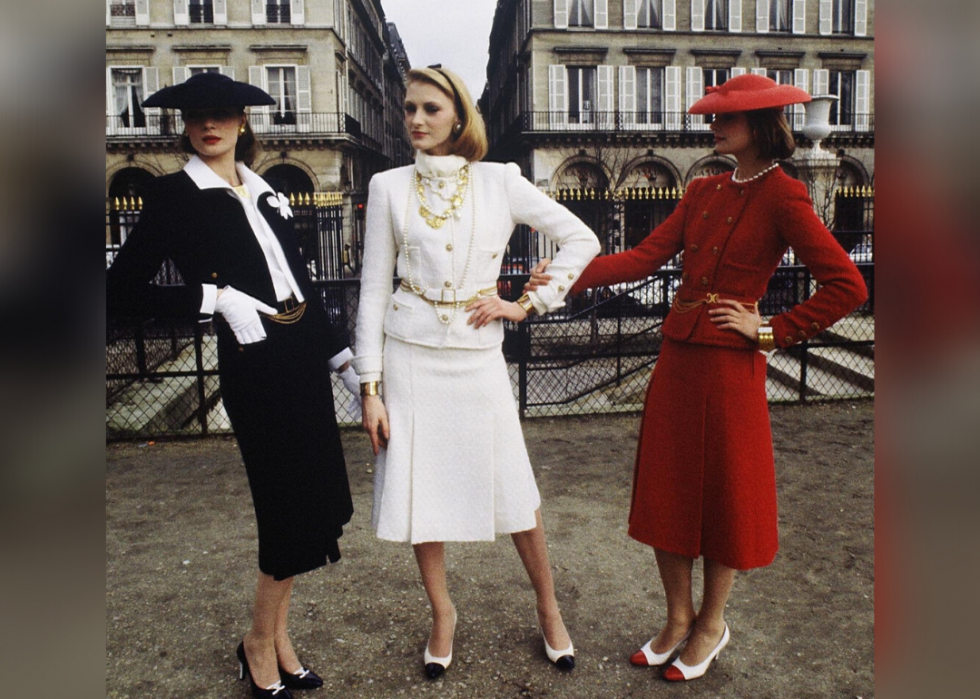
35 / 50
PIERRE GUILLAUD/AFP // Getty Images
Shoulder pads
A new wave of women began entering the workforce en masse in the '80s, which kickstarted the power dressing movement. Blazers, suits, and fifty-fifty dresses boasted shoulder pads to create a structured menswear-inspired look for women in the office.
You may also like: Most popular infant names in America
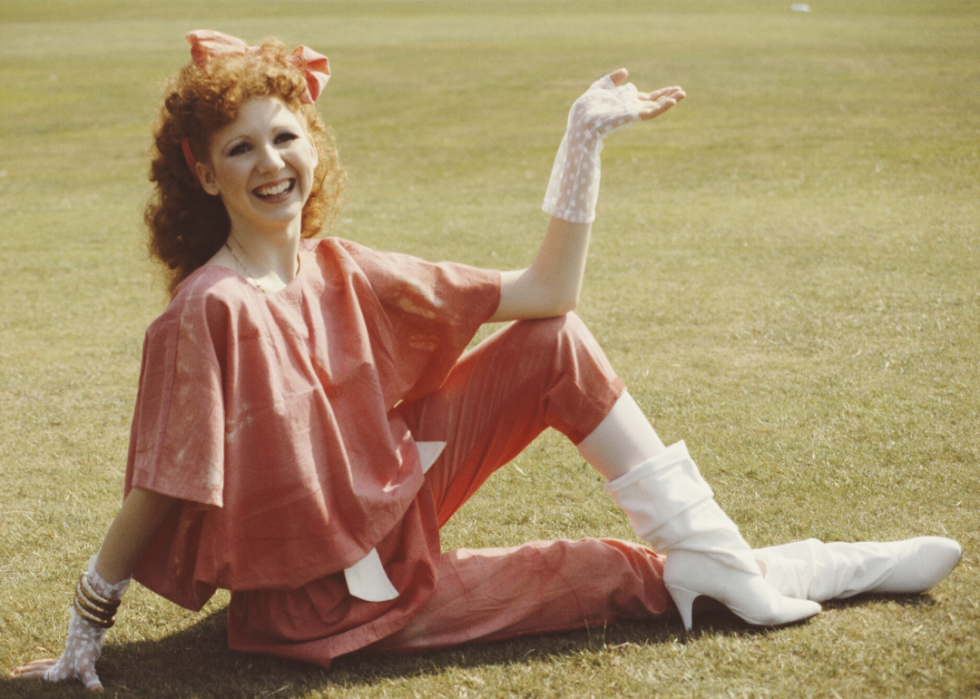
36 / 50
Fox Photos/Hulton Archive // Getty Images
Lace gloves
Most popular on the easily of Madonna fans, lace gloves were an '80s staple along with shoulder pads and big pilus. This look became symbolic of a certain kind of absurd girl at the time.
[Pictured: English language actress Bonnie Langford in 1984.]

37 / 50
Wesley/Keystone // Getty Images
Leggings equally pants
Leggings have come in and out of the manner many times, only the look actually peaked during the '80s, as well known as the Jane Fonda conditioning era. These spandex bottoms came in any and all colors (including neons) and could be worn with T-shirts, leotards, and off-the-shoulder sweatshirts.
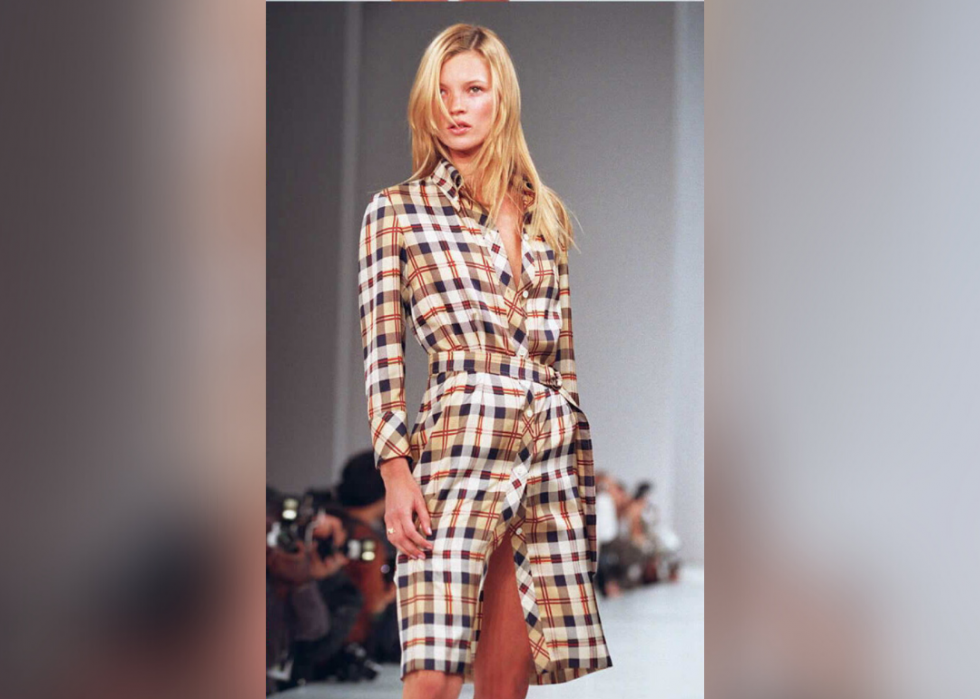
38 / 50
TIMOTHY CLARY/AFP // Getty Images
All-out plaid
Women of the early 1990s were mad for plaid—from grungy flannel shirts to preppy brim-and-blazer ensembles a la Cher from "Clueless" (1995). Designers like Alexander McQueen, Vivienne Westwood, and Marc Jacobs helped brand this cross-hatched design mainstream.
[Pictured: Kate Moss models a shirtdress past Victor Alfaro in 1996.]
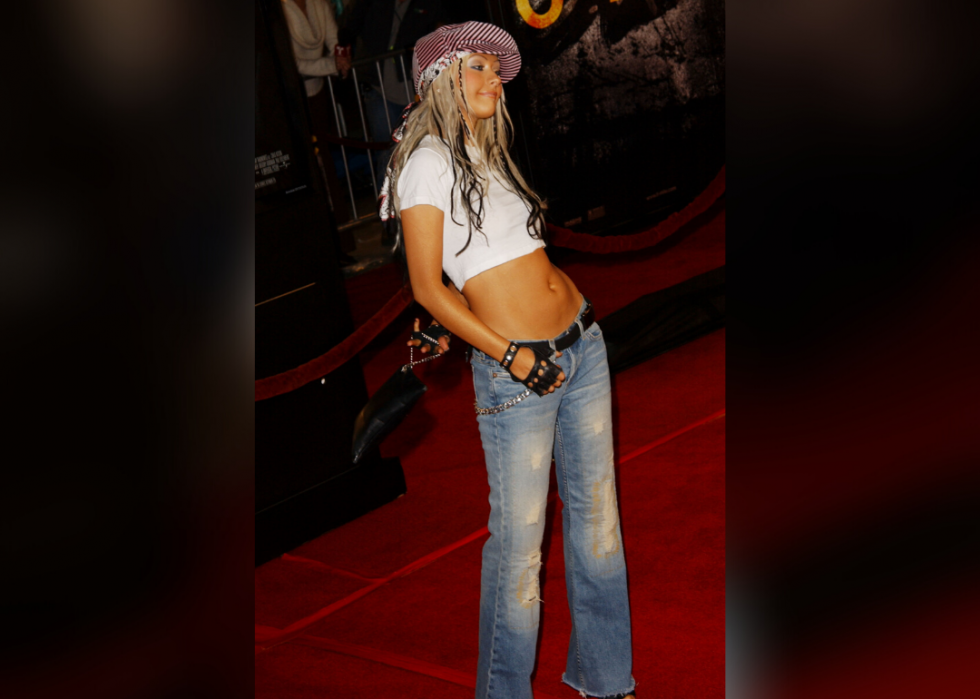
39 / 50
Jon Kopaloff // Getty Images
1990s Acid-done jeans
Though starting time seen in the '60s, acrid-washed jeans became most pop subsequently Guess released the first designer pair of bleach-splattered pants in 1981. A decade later on, heavy metal band members and Hollywood starlets were clad in acid-washed jeans, which made a 2019 comeback, with Kendall Jenner and Bella Hadid seen sporting a pair.
[Pictured: Christina Aguilera attends a pic premiere in 2002.]

40 / 50
Pascal Le Segretain // Getty Images
Belly shirts
Abdomen-baring babes of the 1990s included Gwen Stefani, the Spice Girls, and Christina Aguilera. With pop music at its peak, this was the outset fourth dimension crop tops experienced a major moment in fashion, though come 2018, the exposed midriff was back in full force.
You may likewise similar: fifty ways America is projected to change by 2050
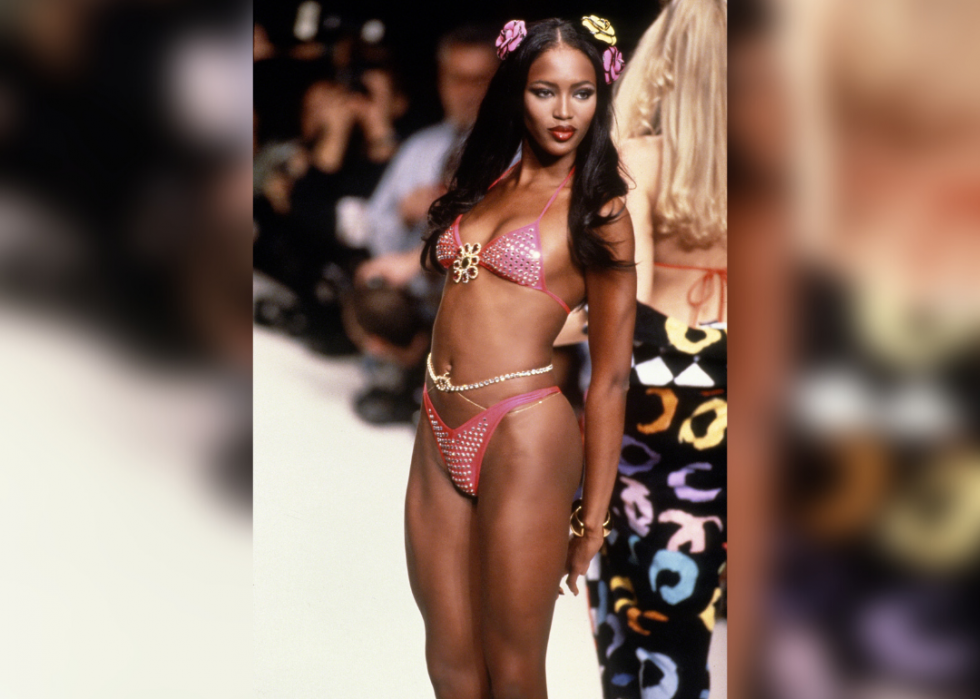
41 / fifty
PL Gould/IMAGES // Getty Images
1990s V-hip swimsuit
In a higher place the hip, or V-hip, swimsuits popular in the '90s are still riding the style moving ridge, with the Zoe Written report boasting a comeback in 2017. The cut of the swimsuit, known for accentuating the legs and cinching the waist, is popular with models Chrissy Teigen and Bella Hadid. However, '80s model/extra Morgan Fairchild may be the most famous V-hip swimsuit model to date.
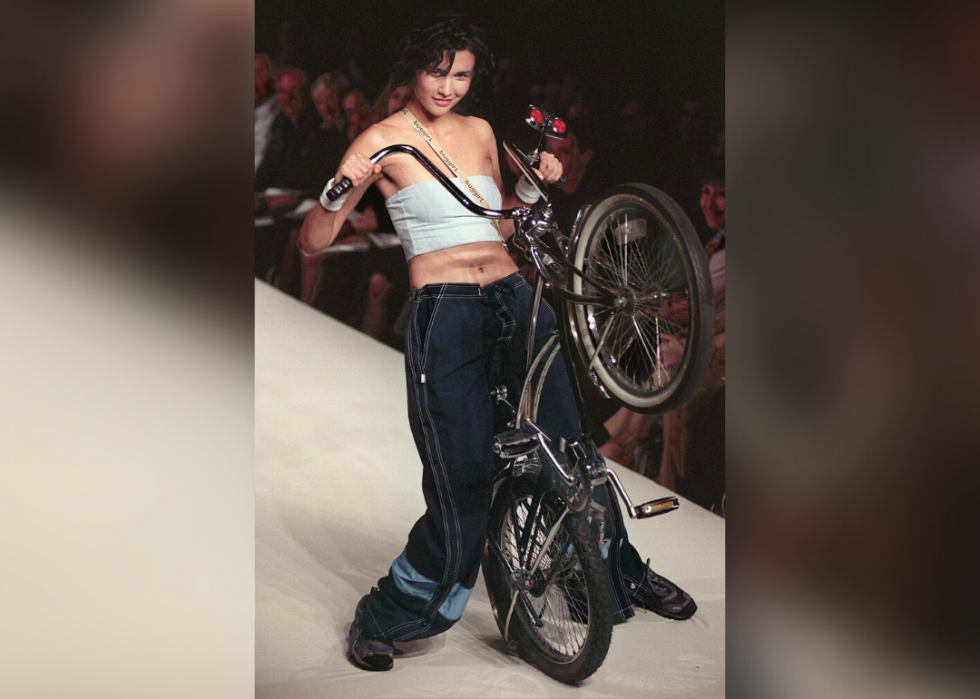
42 / l
STAN HONDA/AFP // Getty Images
JNCO jeans
During the late '90s, women and men alike rocked this unique extra-wide pants tendency, mainly if they were looking to achieve that punk rock aesthetic. Bonus points if yous added a wallet chain and your pant leg circumference was wide plenty to totally cover your skate sneakers.
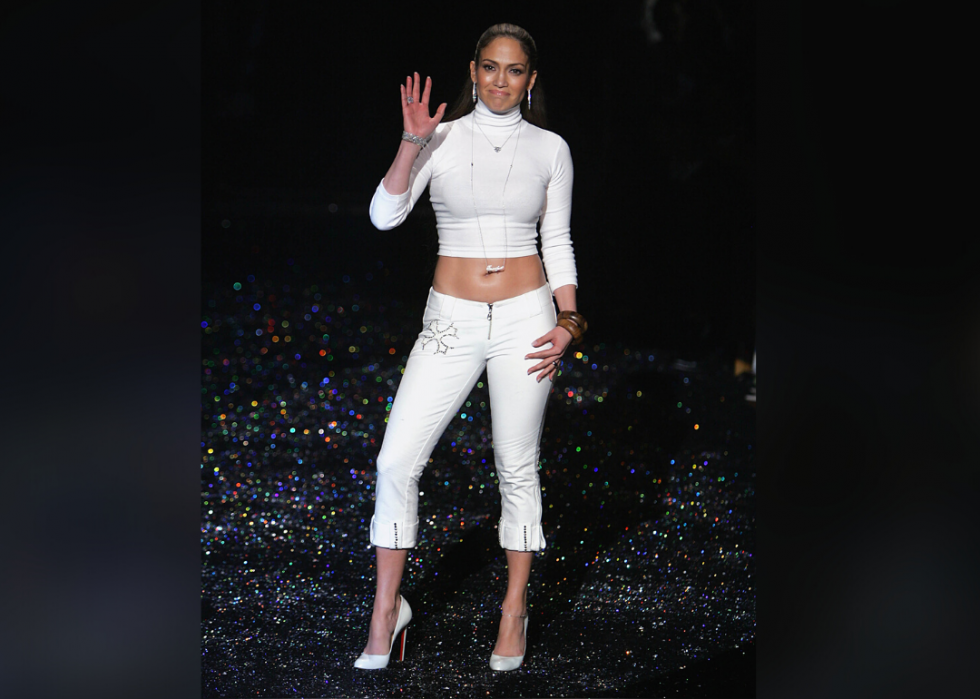
43 / 50
Mark Mainz // Getty Images
Pedal pusher pants
A close cousin of capris, these dogie-length pants (as well chosen "clam diggers") start became pop in the 1950s but showed up once again in many young women's closets circa 2000. They were usually worn tight and cuffed below the knee.
[Pictured: Jennifer Lopez waves at the close of her fashion show in 2005.]
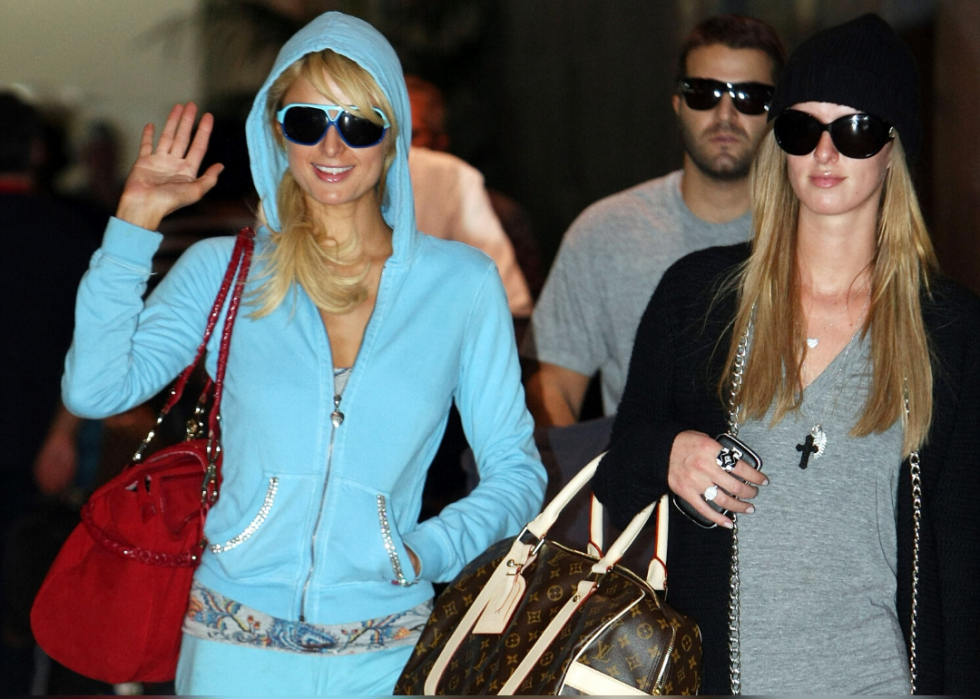
44 / 50
Kristian Dowling // Getty Images
Tracksuits in every color
Matching velour and terry textile tracksuits were a phenomenon throughout the late '90s and the '00s, thanks to big celebs similar Paris Hilton, Lindsay Lohan, and J.Lo. To reach the full await, i needed the goose egg-up top that showed midriff, the matching drawstring bottoms, and to accessorize with an oversized handbag and trucker chapeau.
[Pictured: Paris Hilton (50) waves equally she walks the airport in 2008.]

45 / 50
Marker Mainz // Getty Images
2000s trucker hats
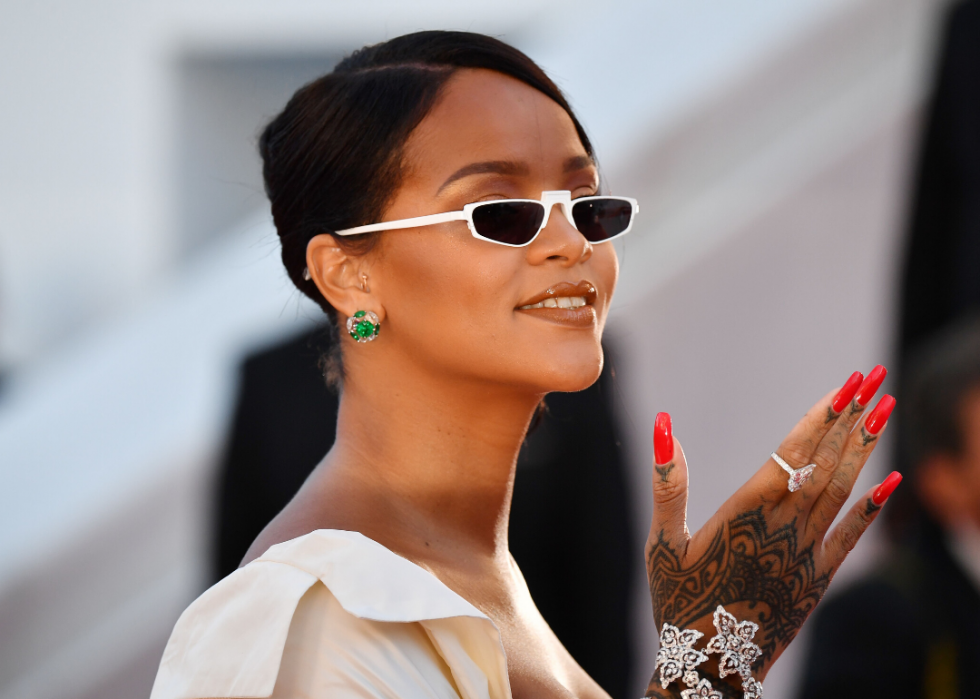
46 / 50
ALBERTO PIZZOLI/AFP // Getty Prototype
2010s Tiny sunglasses
Though pop in 2010, the tiny sunglass trend featured on the rim of John Lennon'due south olfactory organ in the '60s hasn't necessarily stood the test of time, with comedian Mindy Kaling and actress Anne Hathaway frowning on gimmicky interpretations. However, Kendall Jenner, Bella Hadid, and Rihanna meet the matter differently—all have been seen in tiny sunglasses on multiple occasions.
[Pictured: Rihanna walks the red carpeting in Cannes in 2017.]
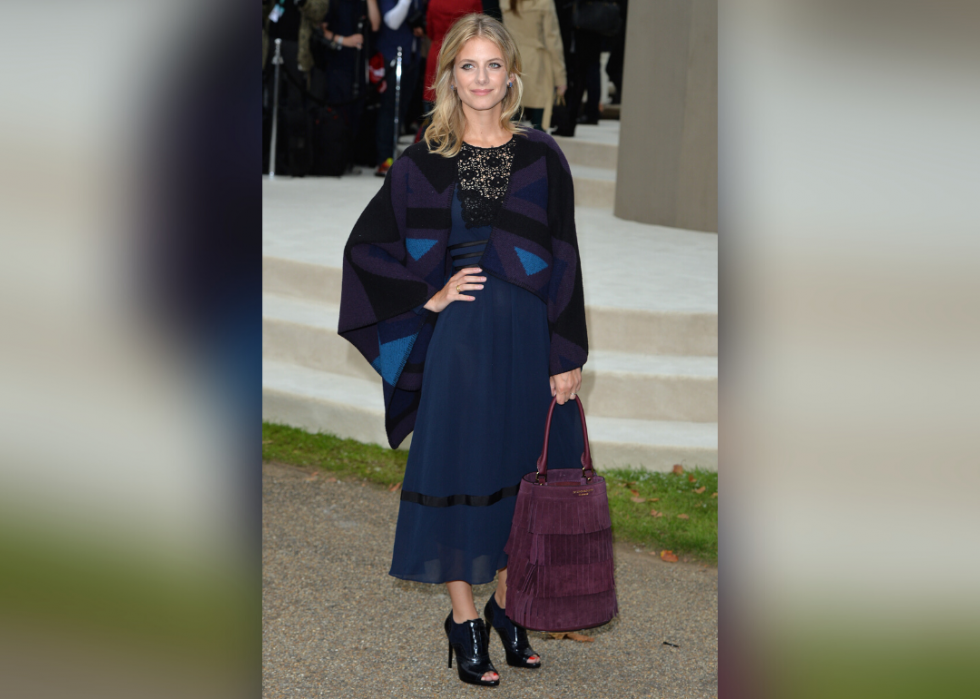
47 / 50
Anthony Harvey // Getty Images
2010s Booties (talocrural joint boots)
The Guardian predicted this 2010 way tendency a yr earlier, specifically calling out the many shapes and sizes it would come in. As reported, 2010 was the year of the spiked-heel, open-toed booties, which originate from the 1800s. A-listers Emma Stone and Jennifer Lawerence sport the short boots alongside Rihanna and Hailey Baldwin, aka, Mrs. Beiber.
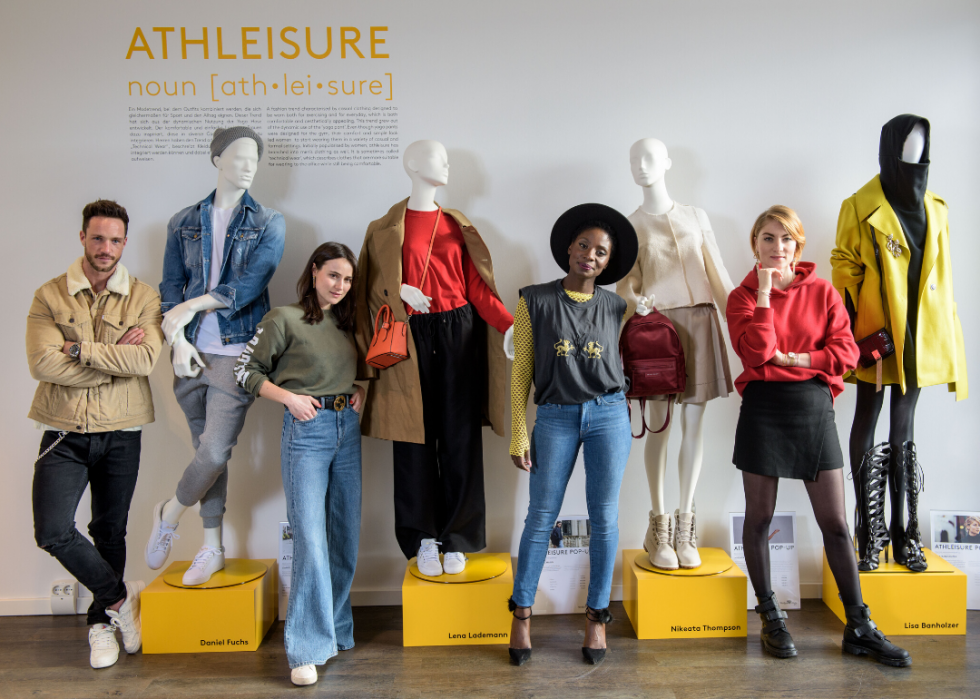
48 / l
Thomas Lohnes // Getty Images for Wertheim Village
Athleisure for everyday
Athleisure refers to exercise clothing that tin also transcend into social activities like brunch, shopping, and schoolhouse. Athleisure is where condolement meets style and was ane of 2018's biggest fashion movements. Celebrities, bloggers, and regular women alike all jumped on board, ofttimes choosing to article of clothing joggers and leggings over denim.
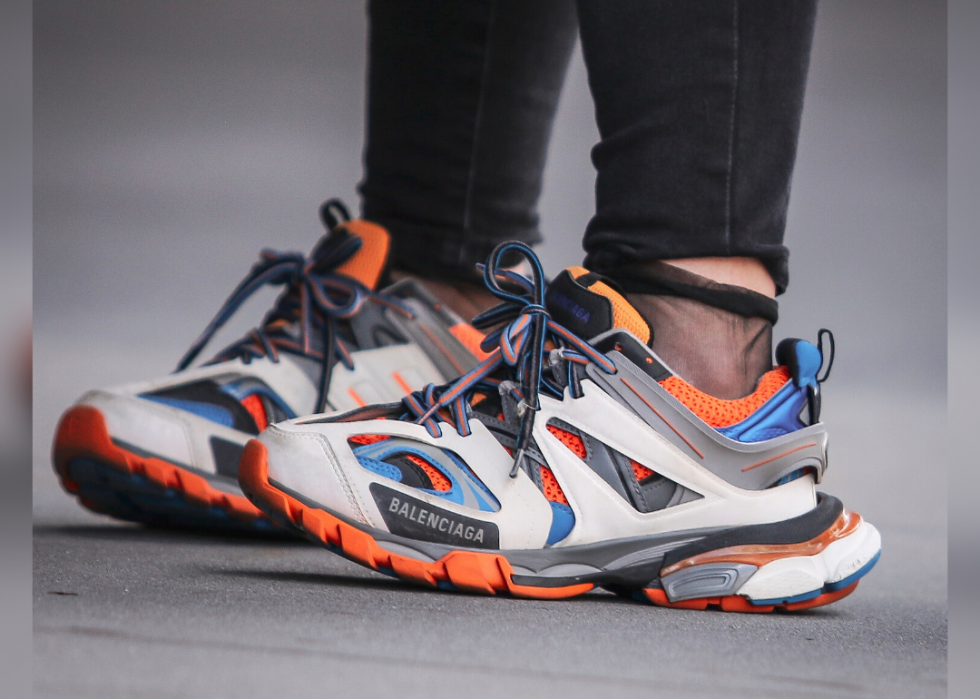
49 / 50
Arturo Holmes // Getty Images
Chunky sneakers
2019 marks the yr that ugly dad sneakers became a legitimate fashion trend. Designer Balenciaga spearheaded the lewk on the runway at 2018 Bound/Summertime Paris Fashion Week. Soon enough, A-listers like Bella Hadid and Kendall Jenner were seen pairing their chunky statement sneaks with blazers, trench coats, jeans, silk slips, y'all proper name it.
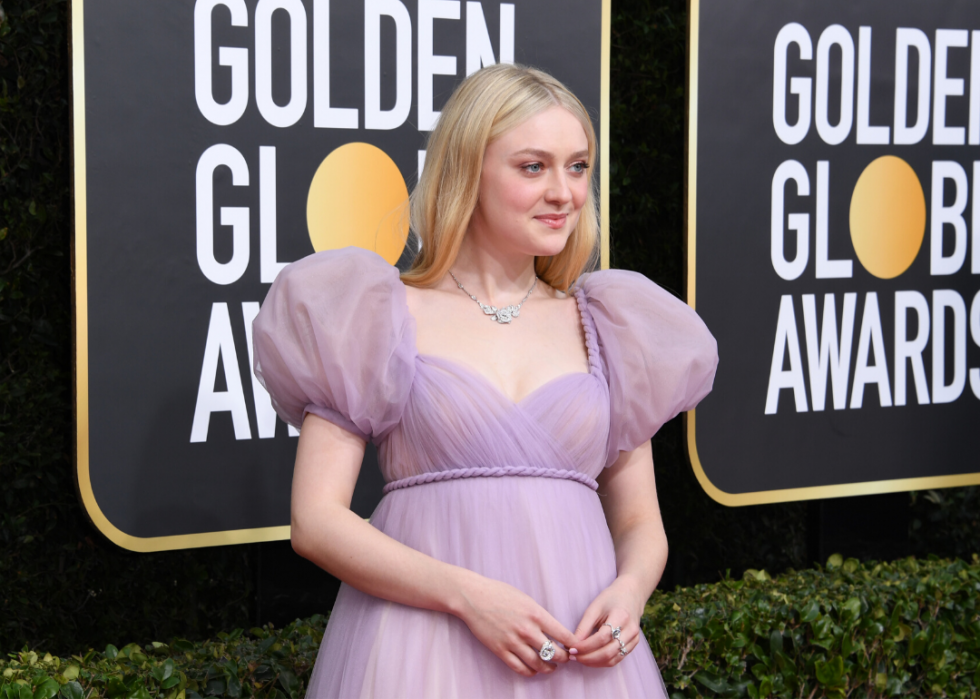
50 / l
Jon Kopaloff // Getty Images
2020 oversized victorian sleeves
The TrendSpotter saw this 1 coming, calling out oversized Victorian sleeves as the adjacent big matter at the Jump/Summertime 2020 Fashion Week. Similar to the '80s puff sleeve, the oversized Victorian was all the roar at this twelvemonth's Gilt Globes, with everyone from Beyonce to Dakota Fanning wearing the style well.
[Pictured: Dakota Fanning attends the Golden World Awards in January 2020.]
You may also like: Baby names that have faded into obscurity
Trending Now
© Stacker 2022. All rights reserved.
0 Response to "Different Styles of Fashion Timeline for Women"
Post a Comment